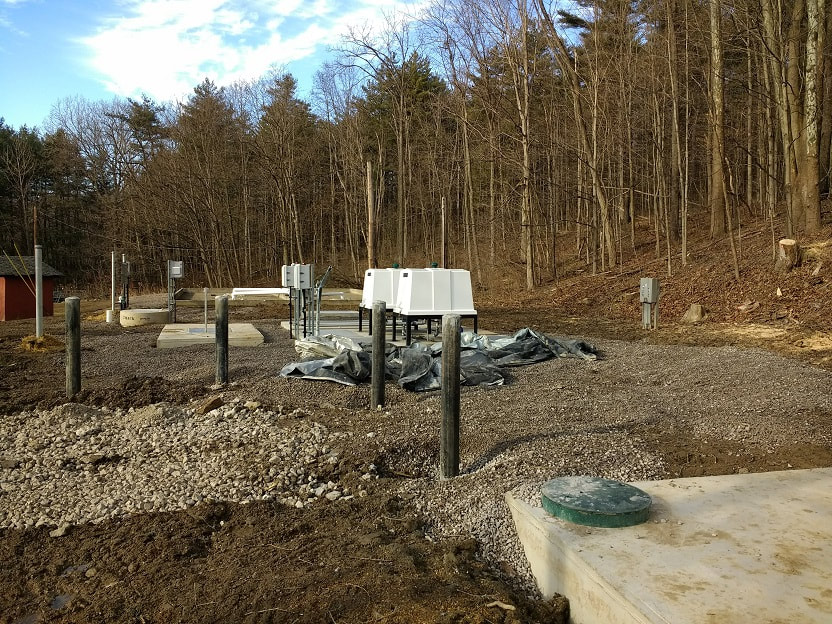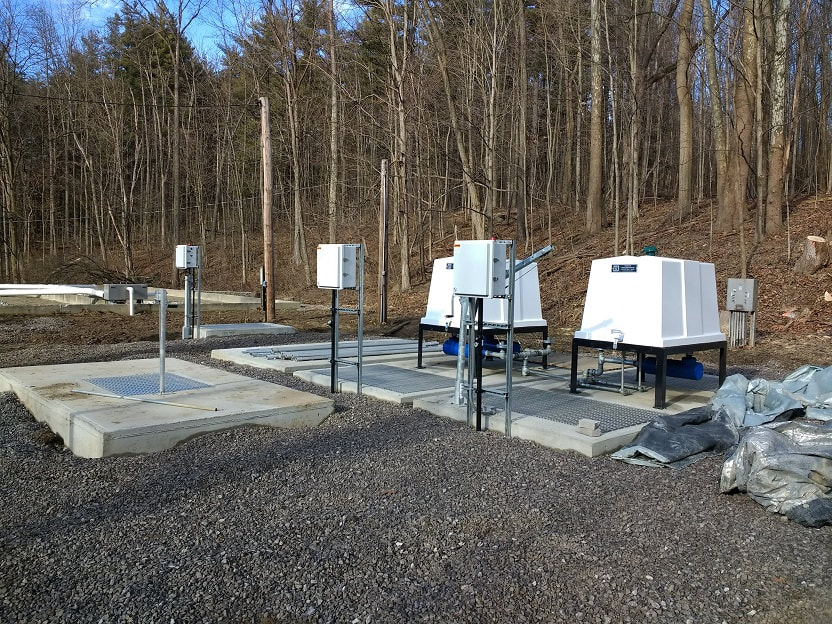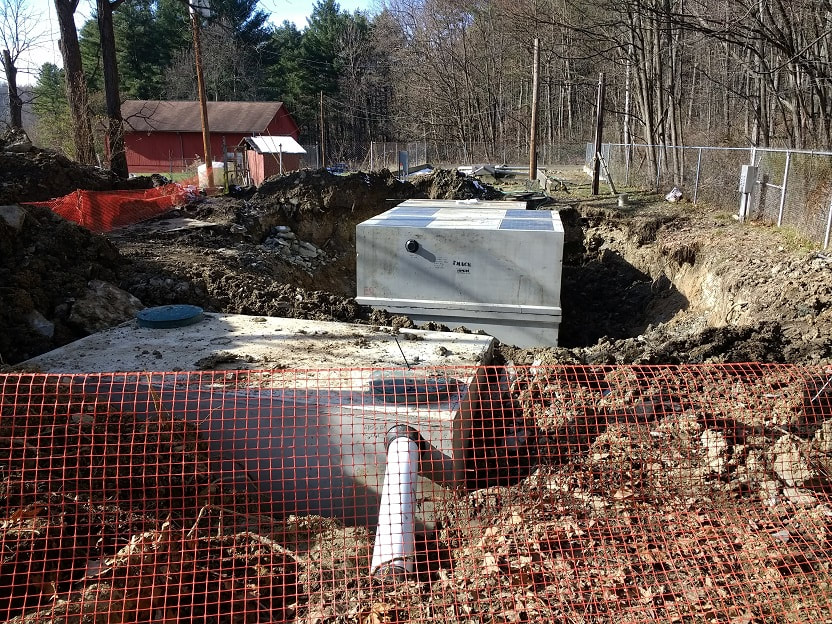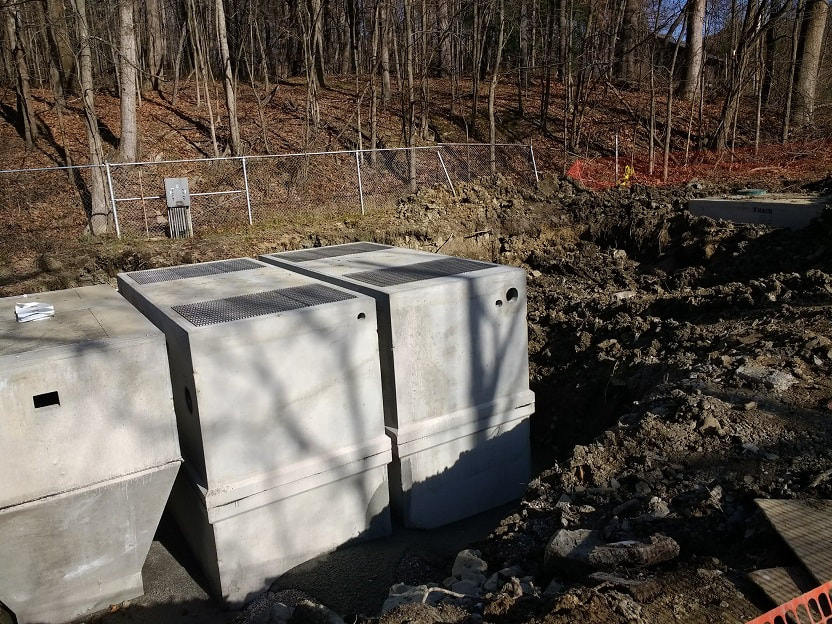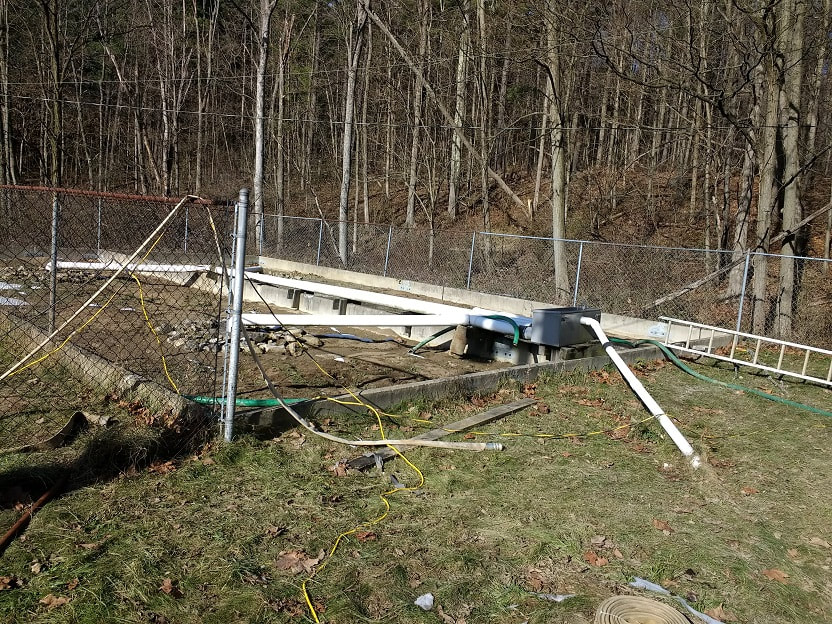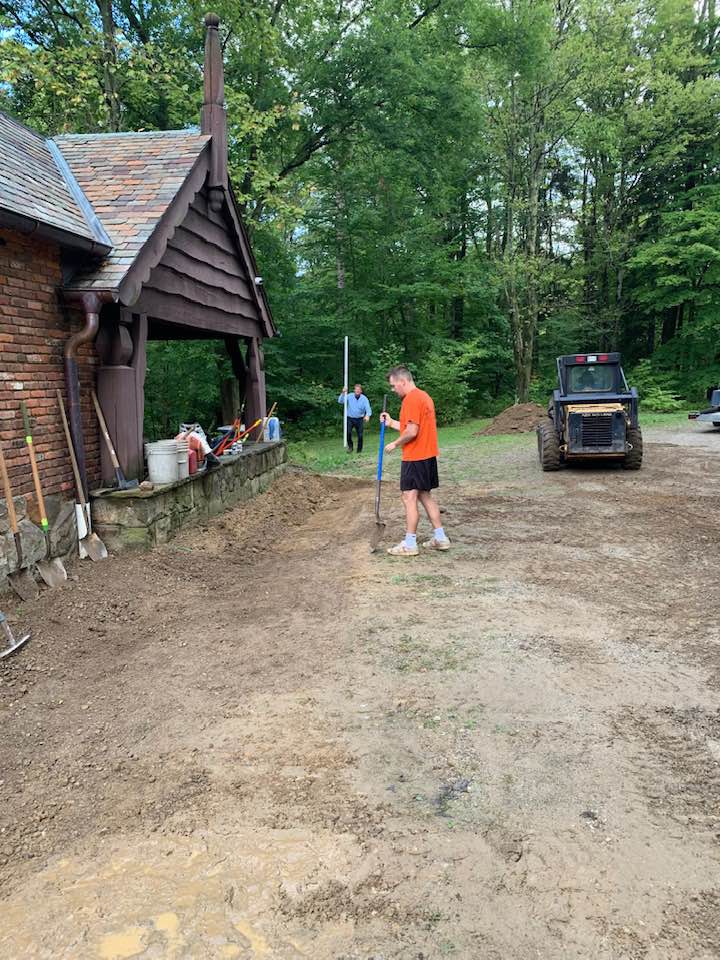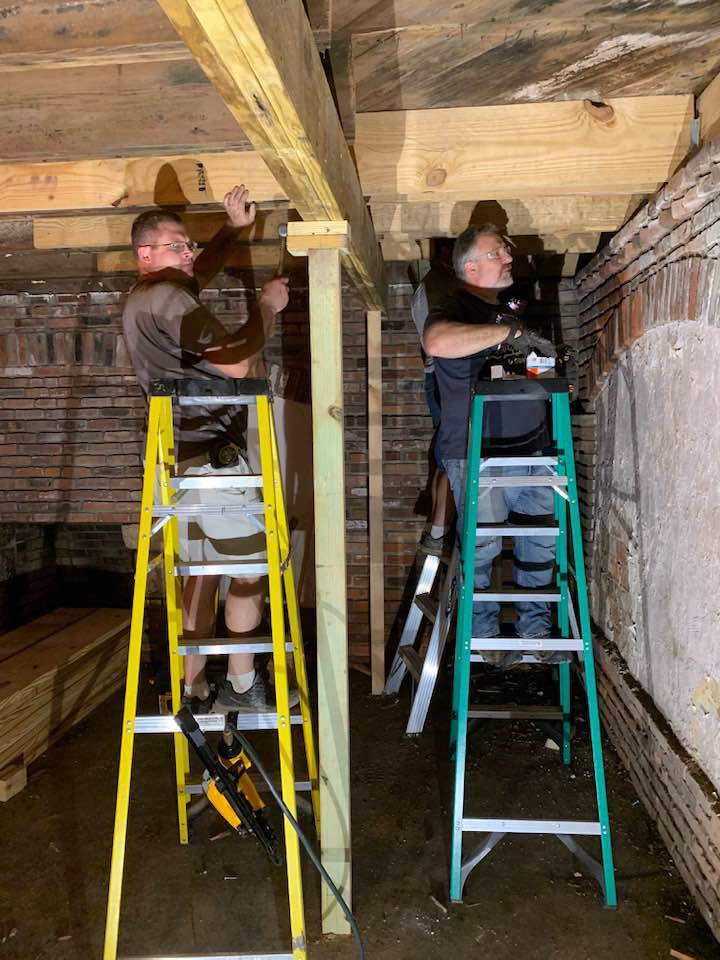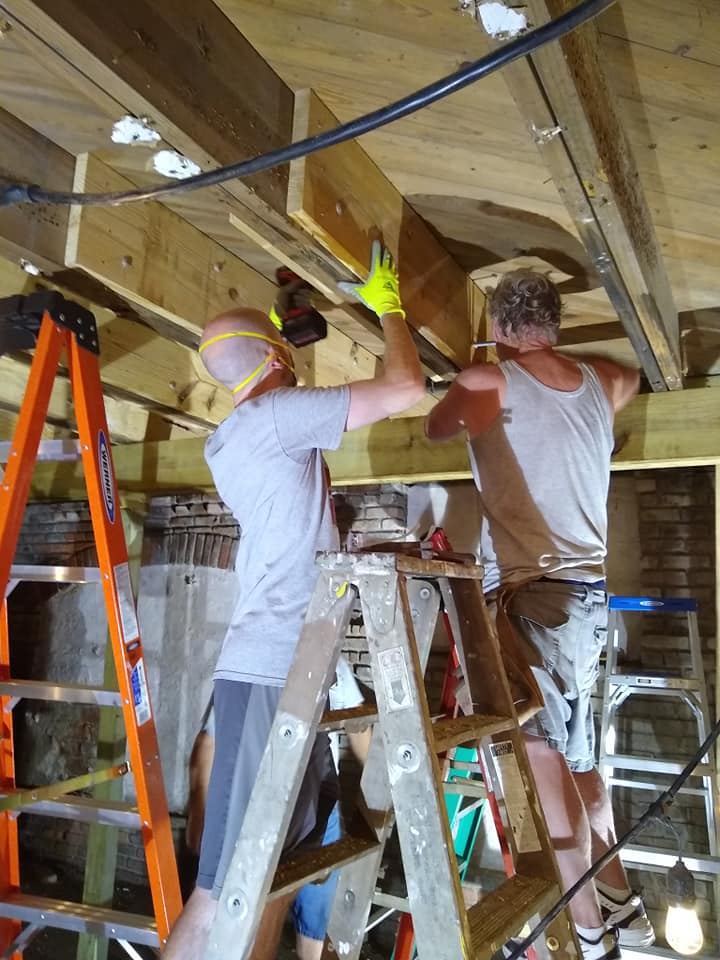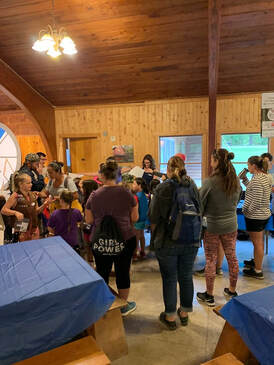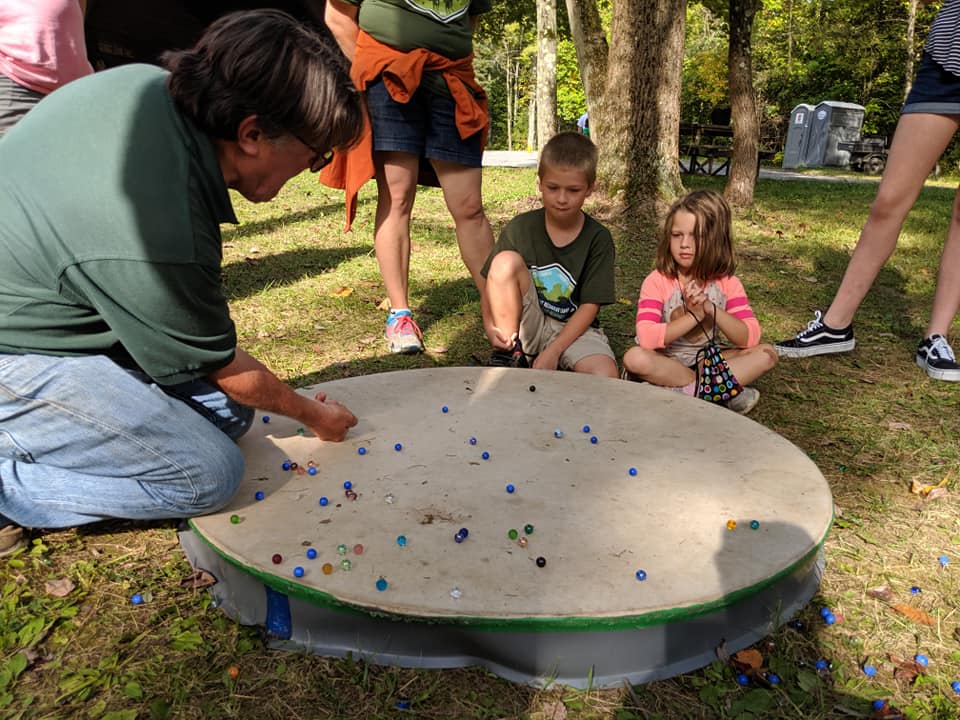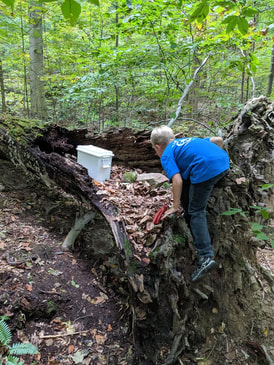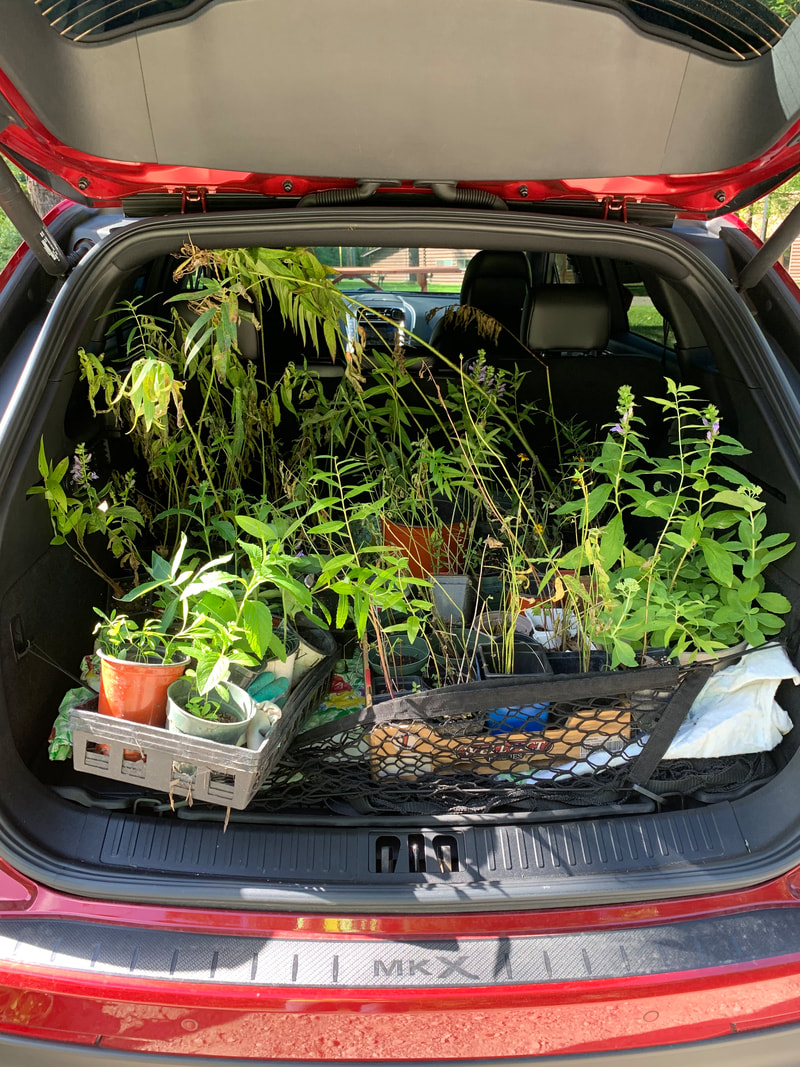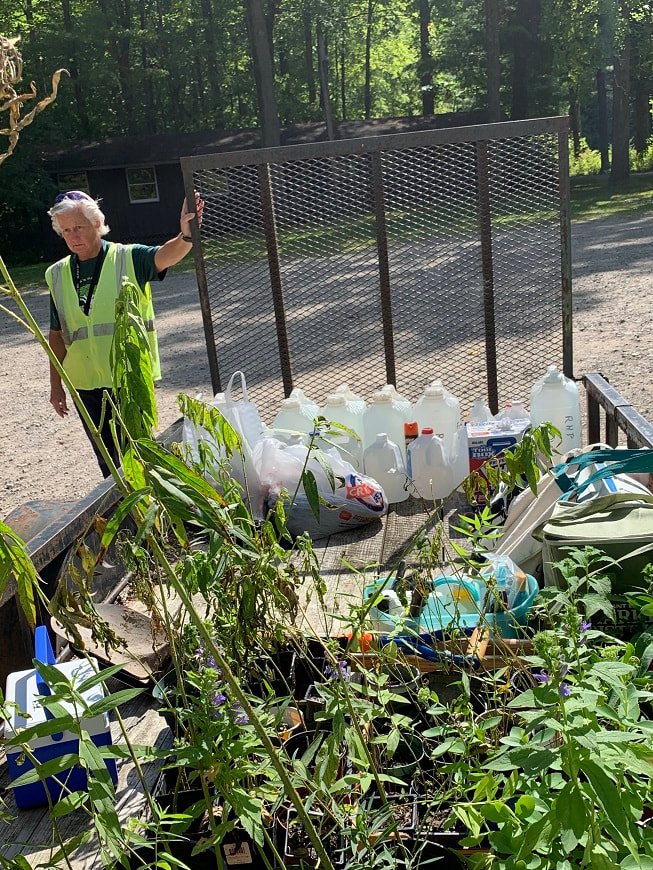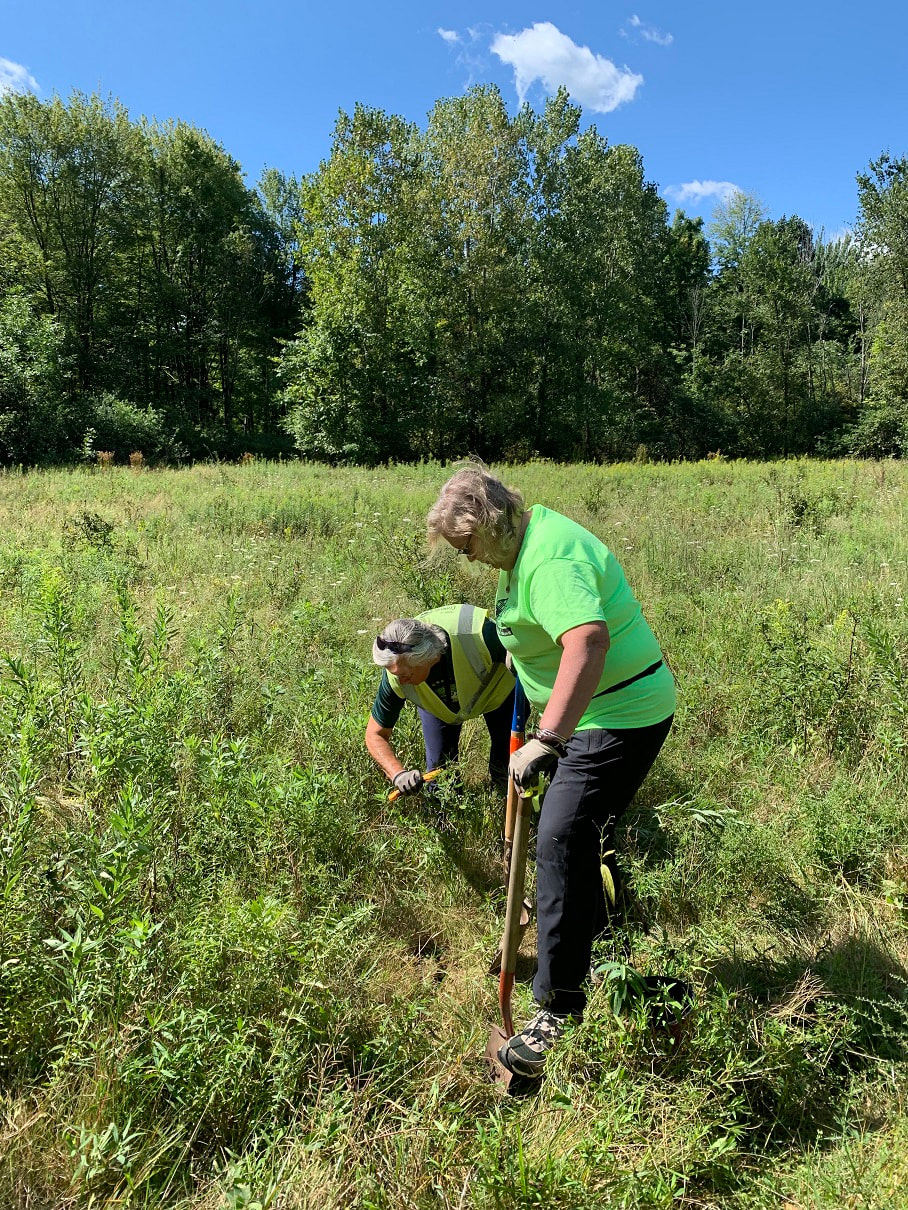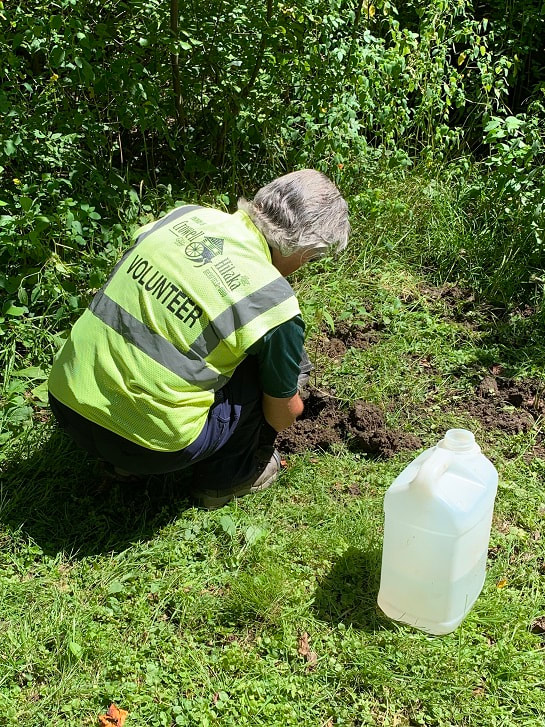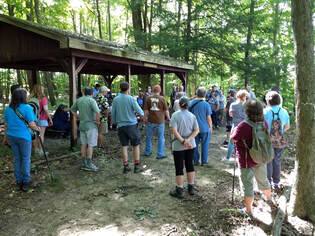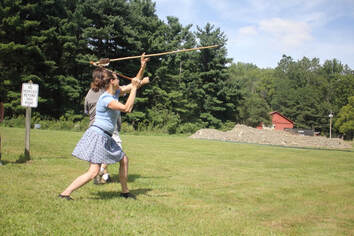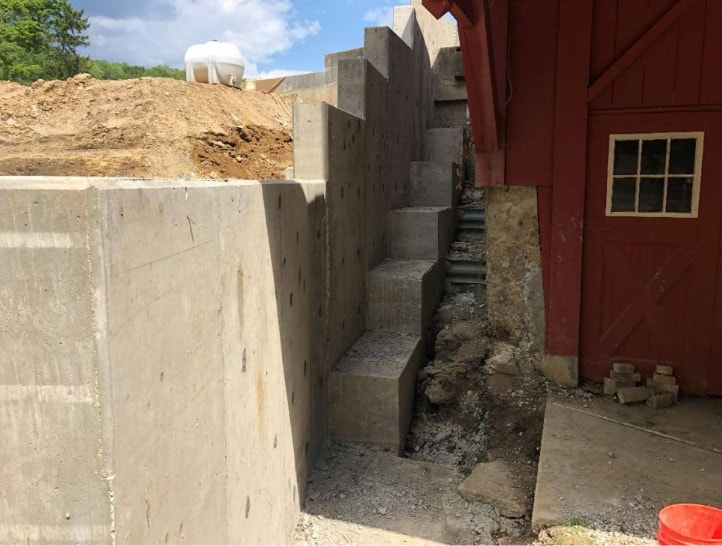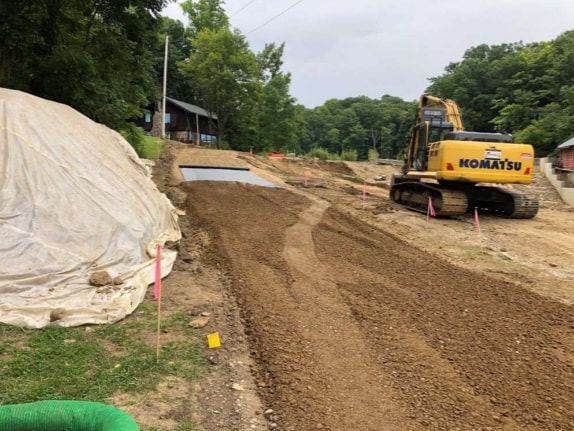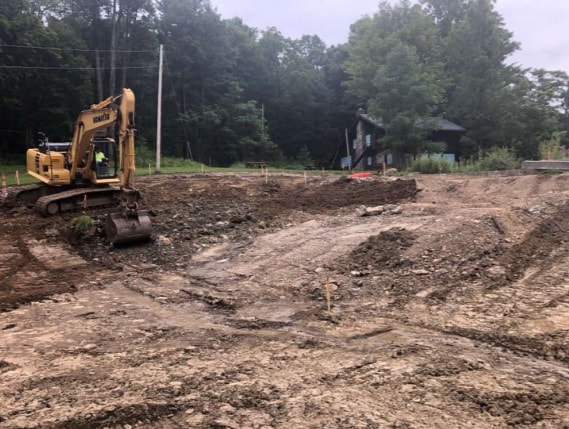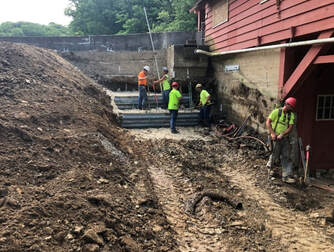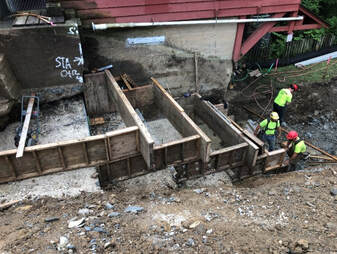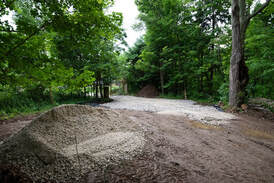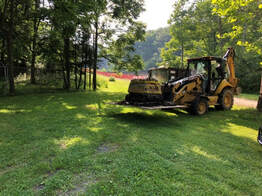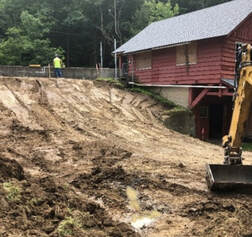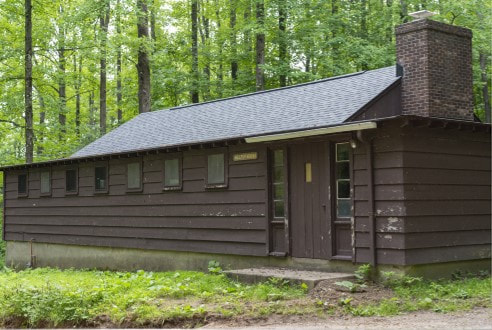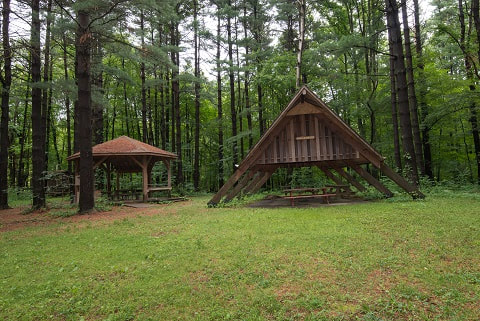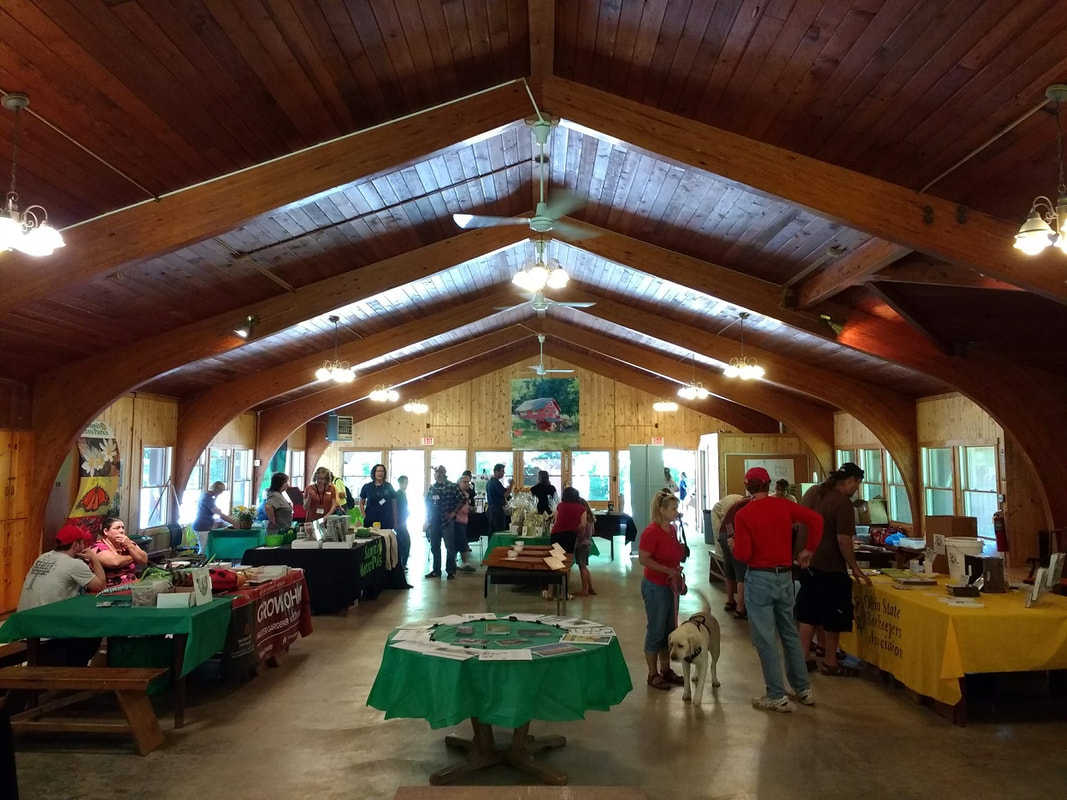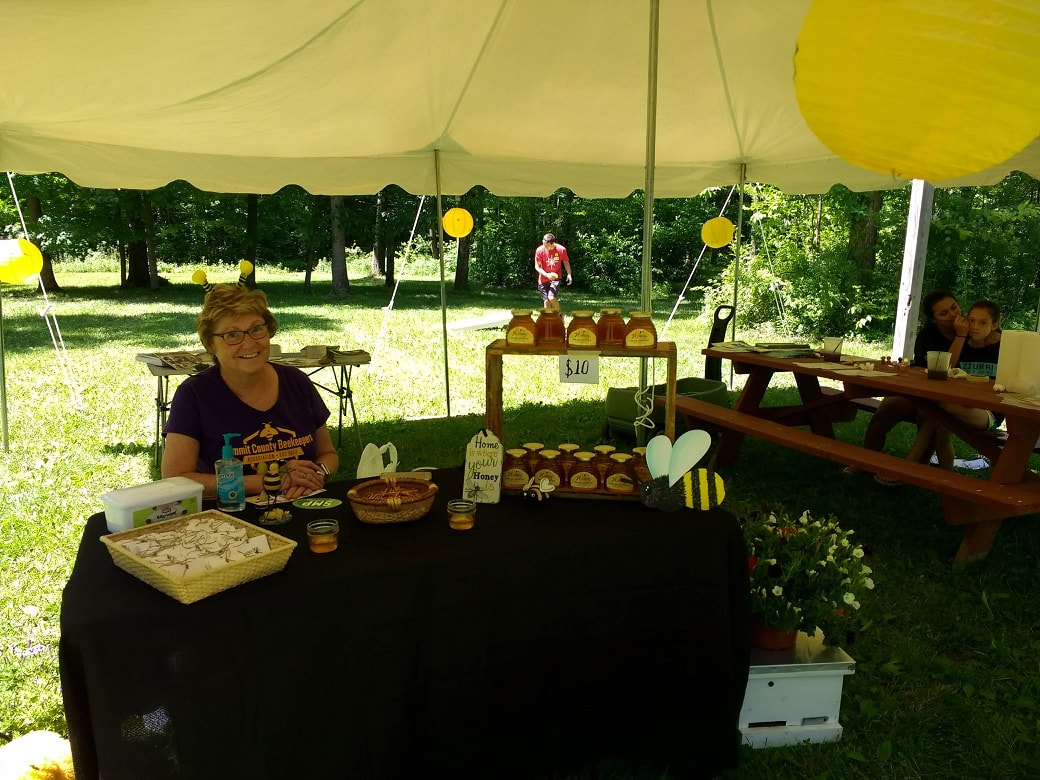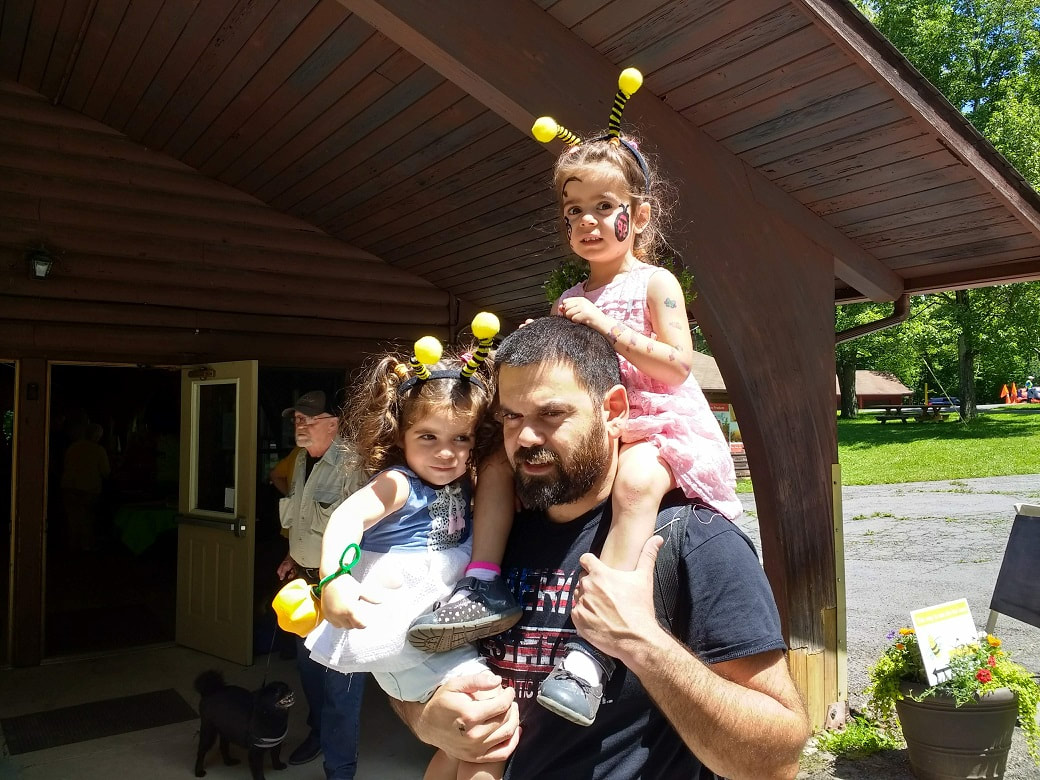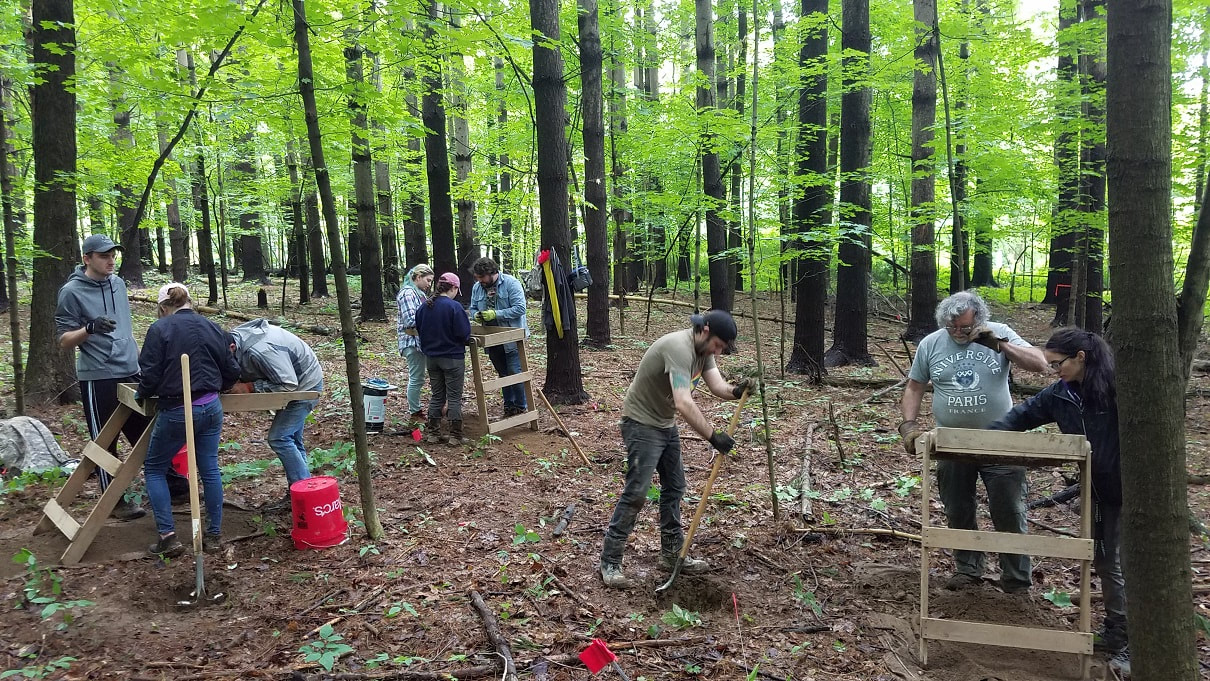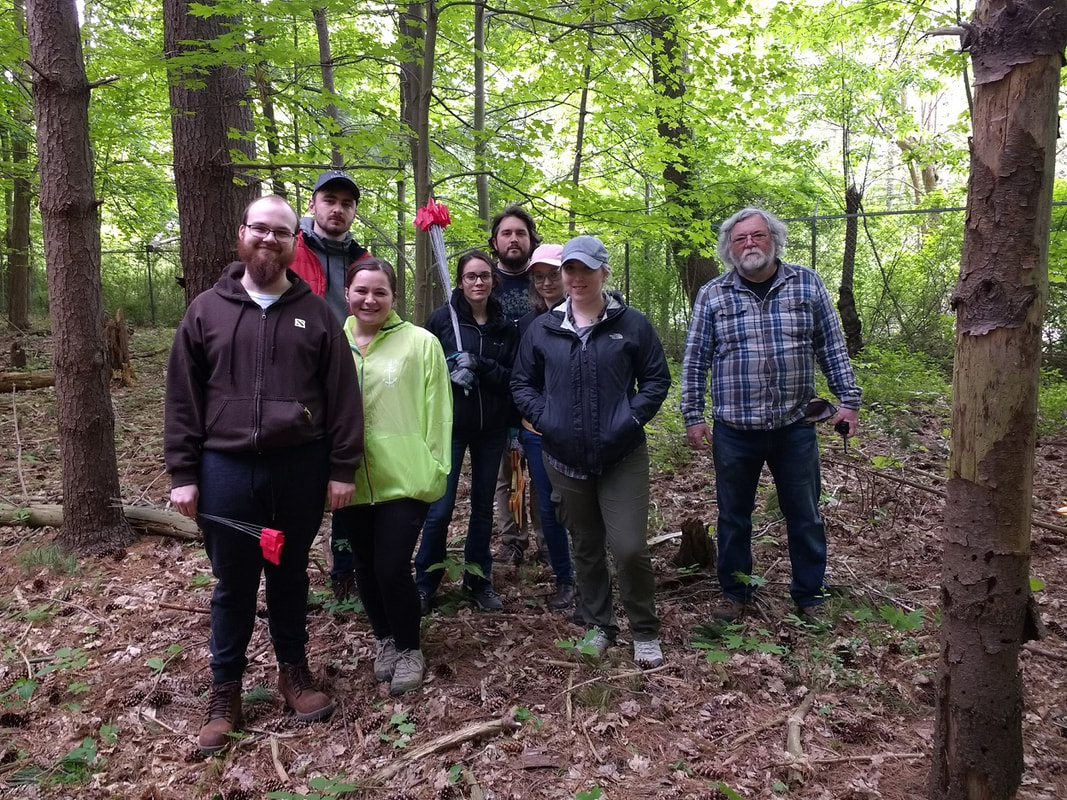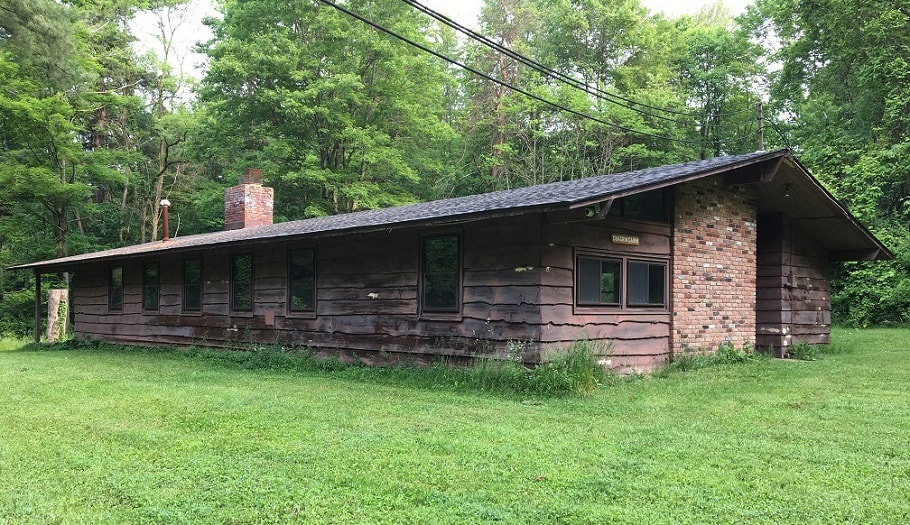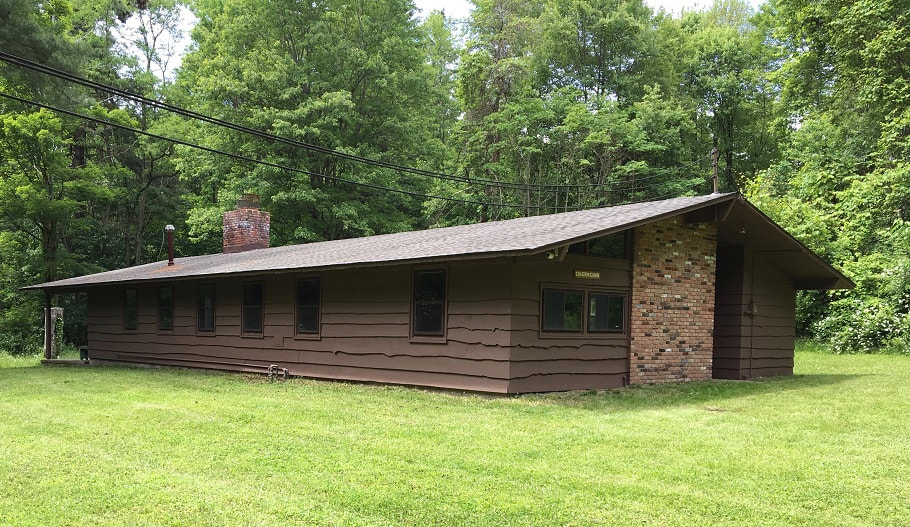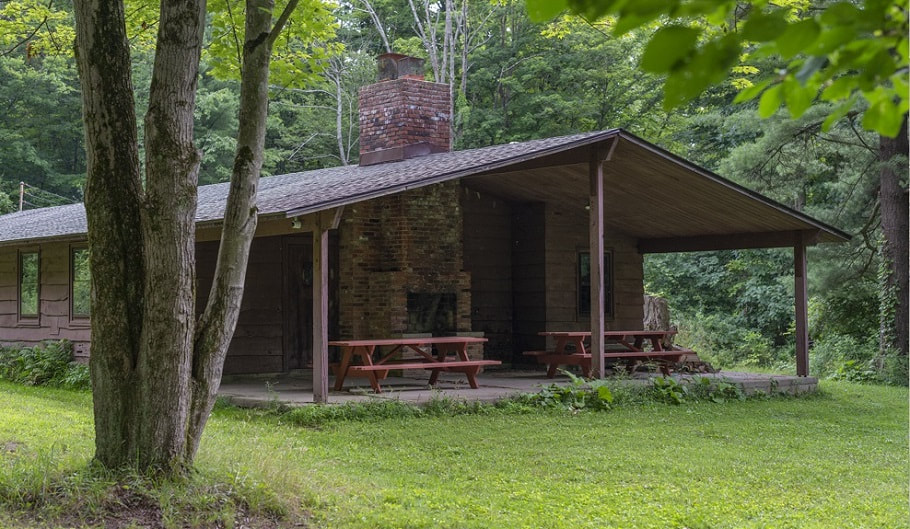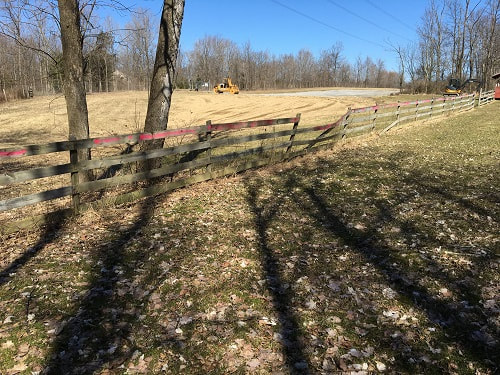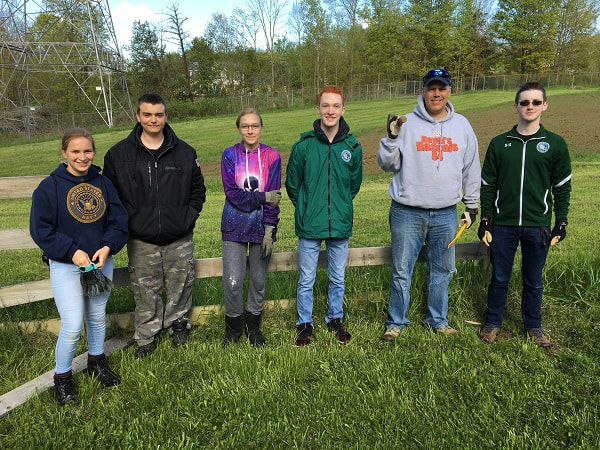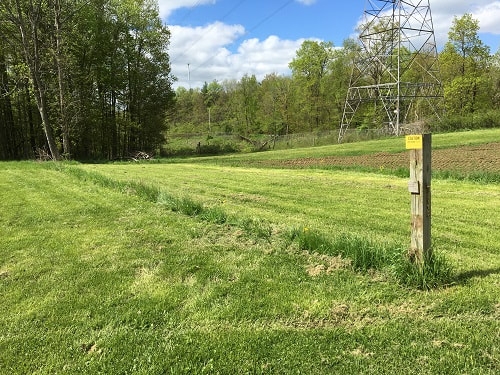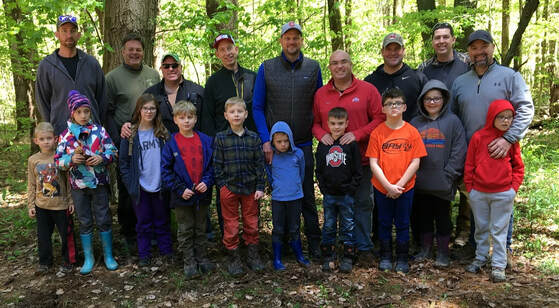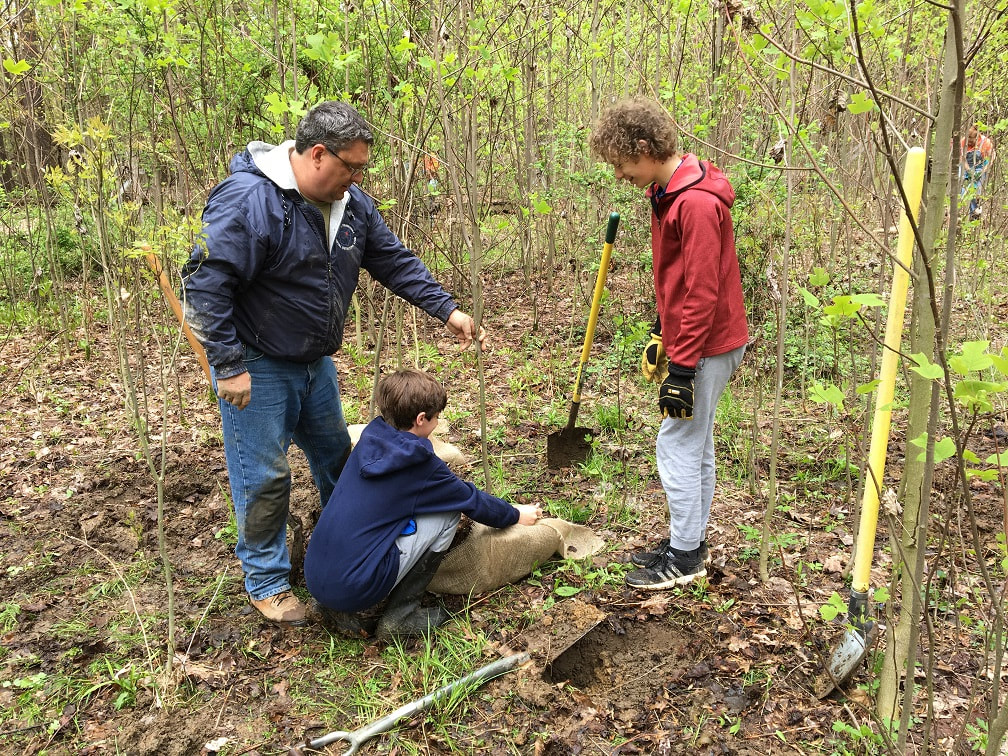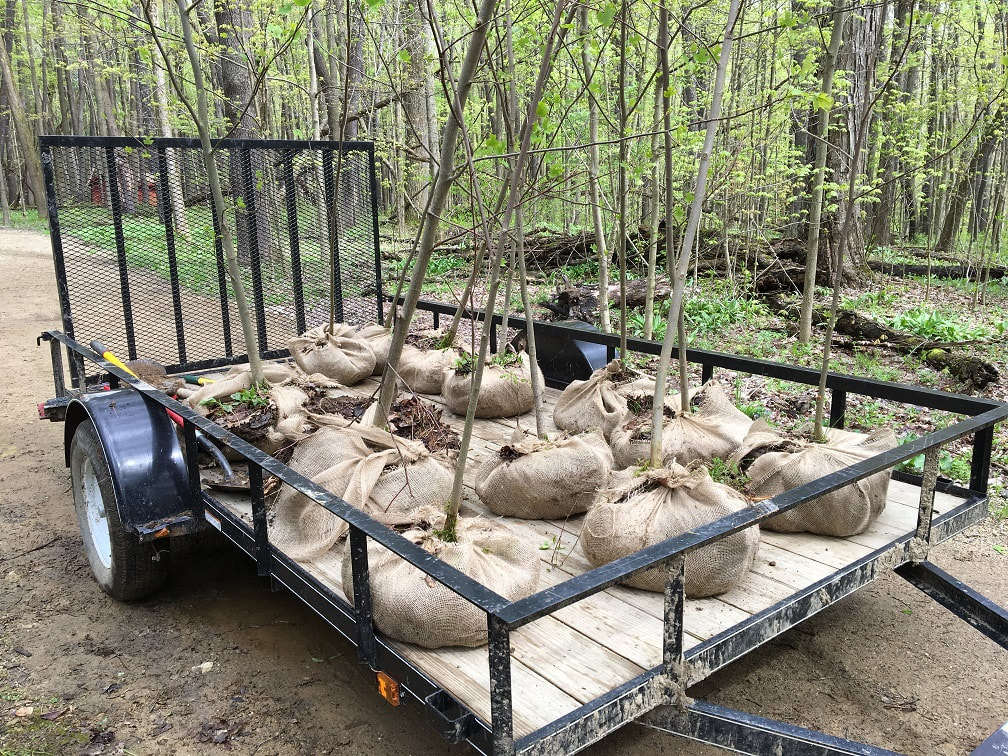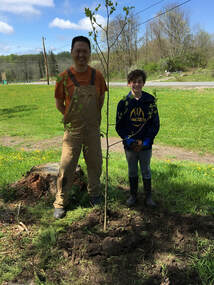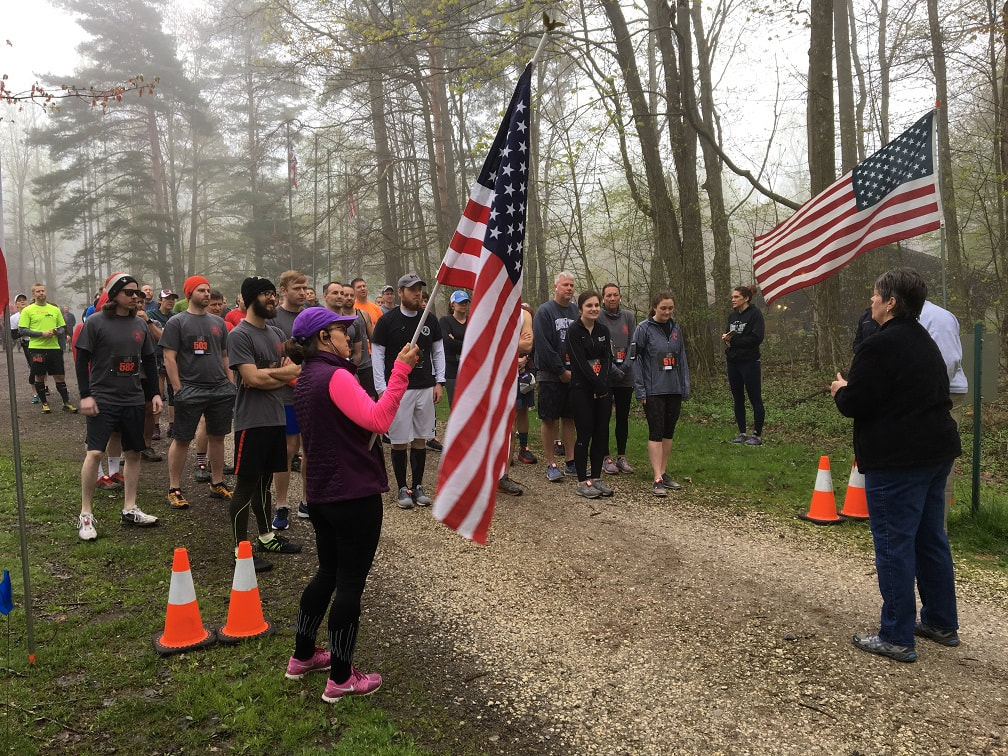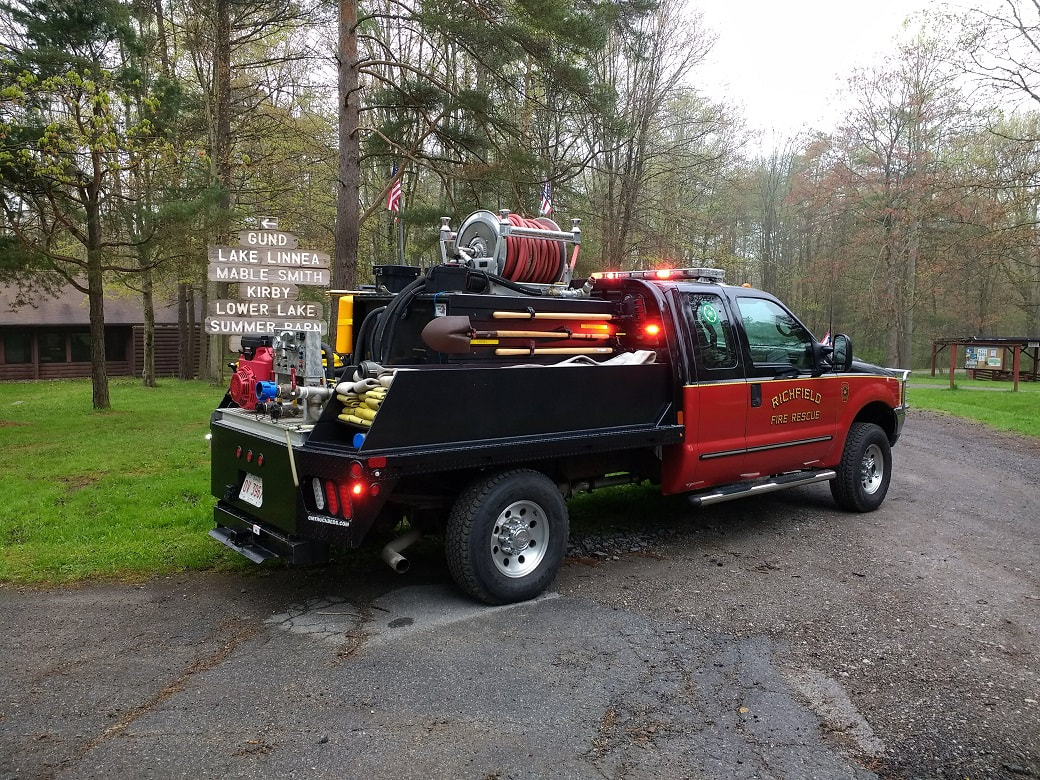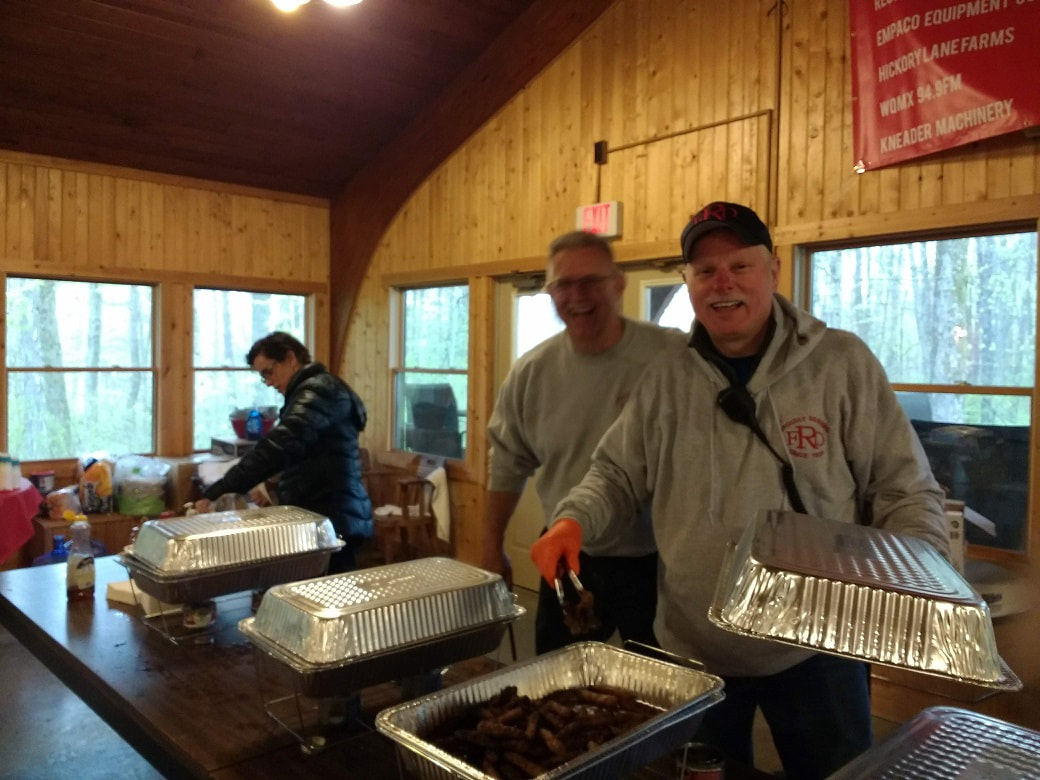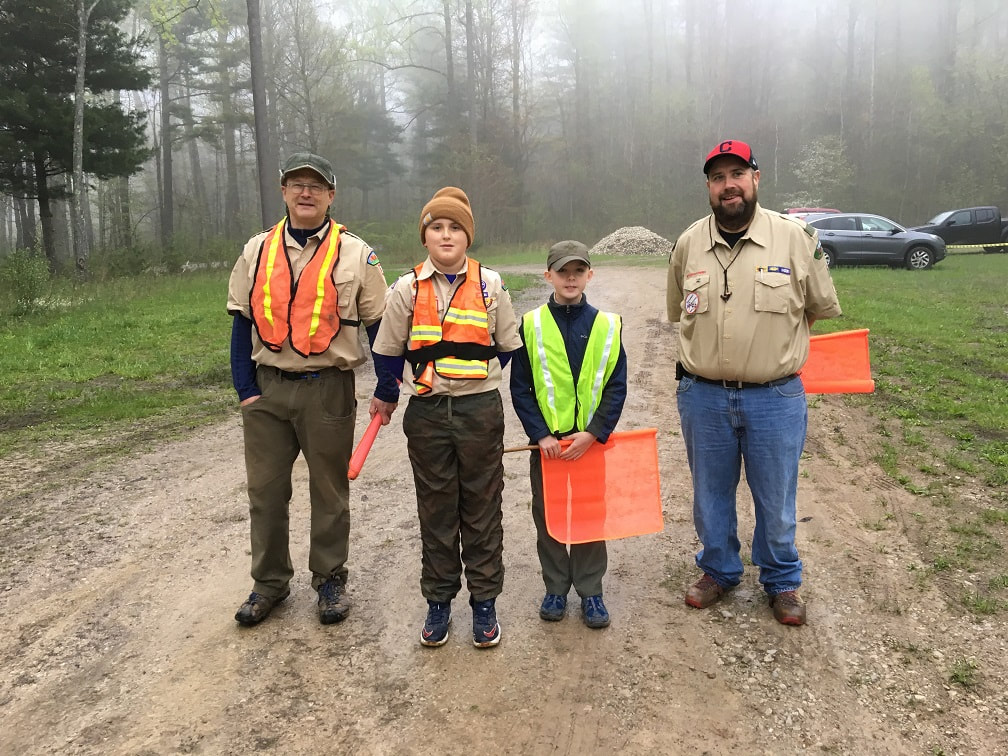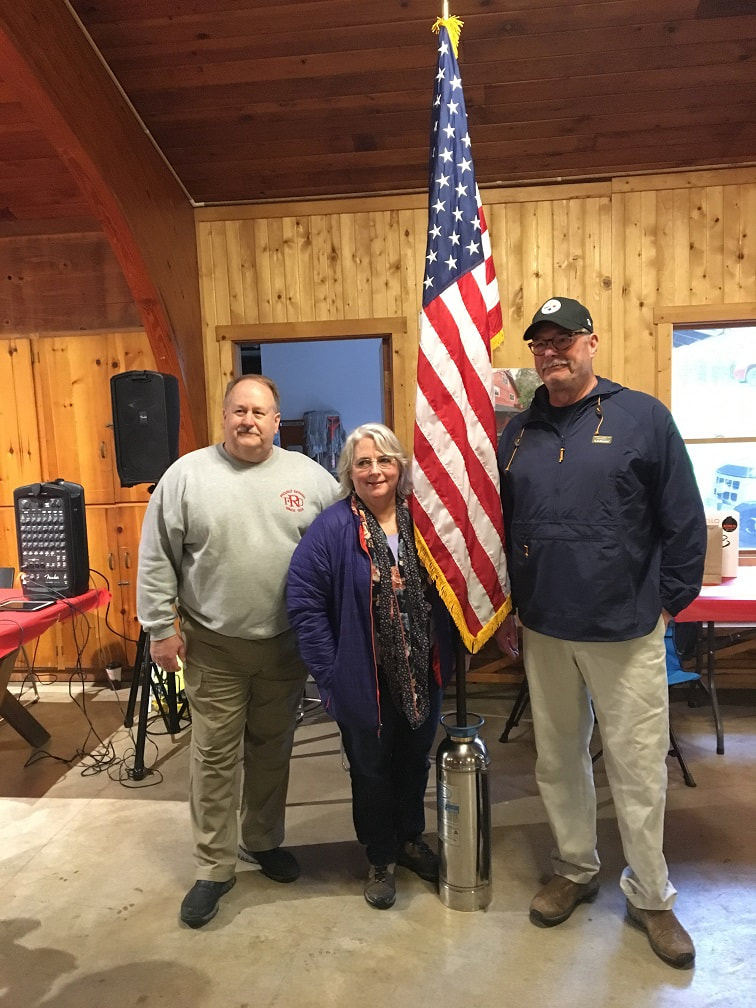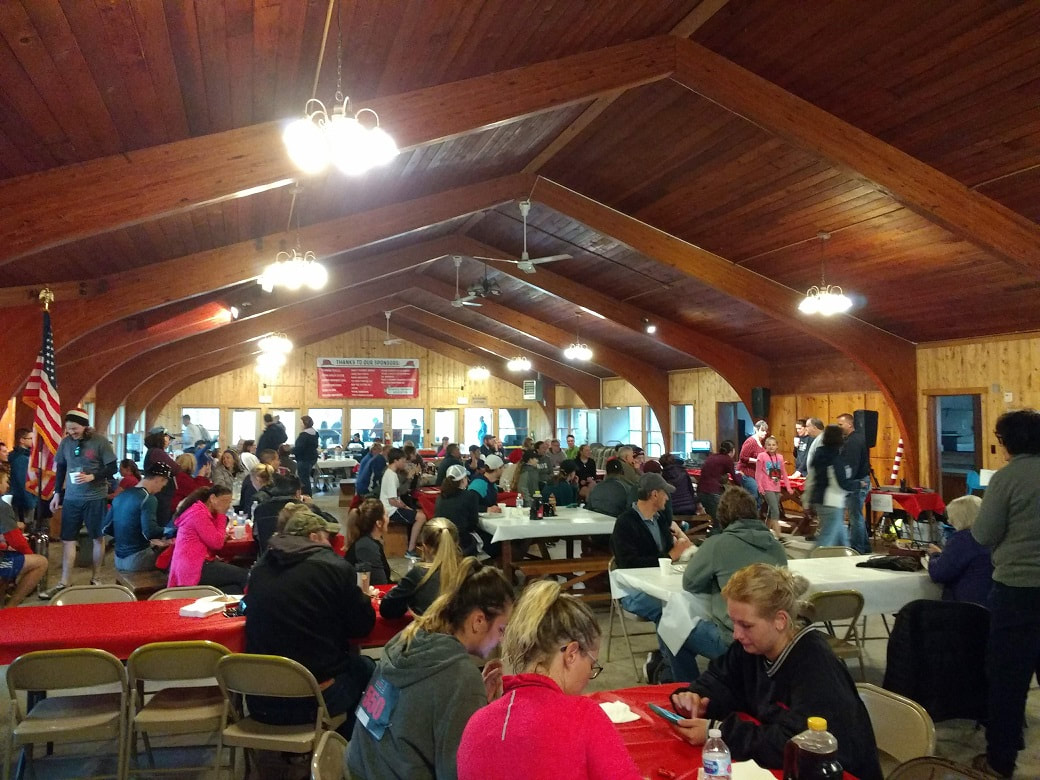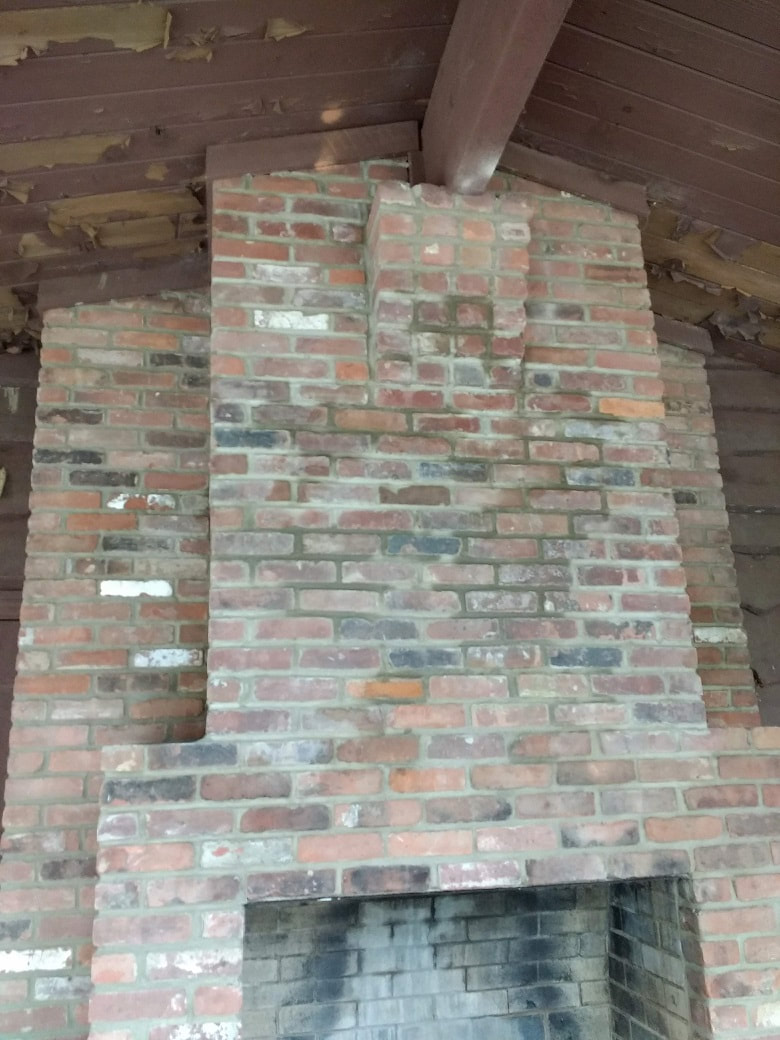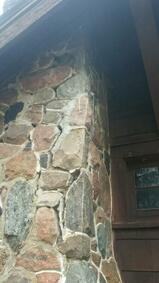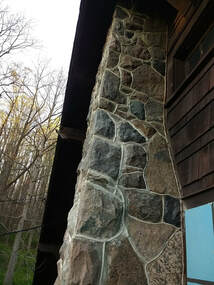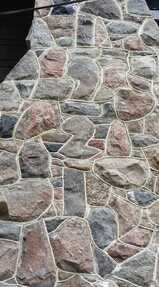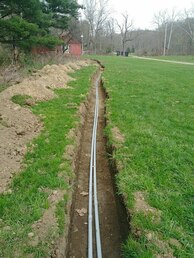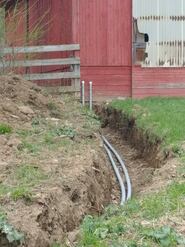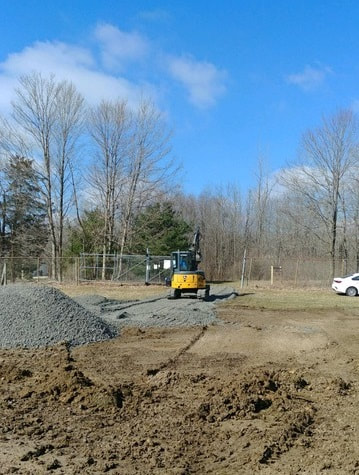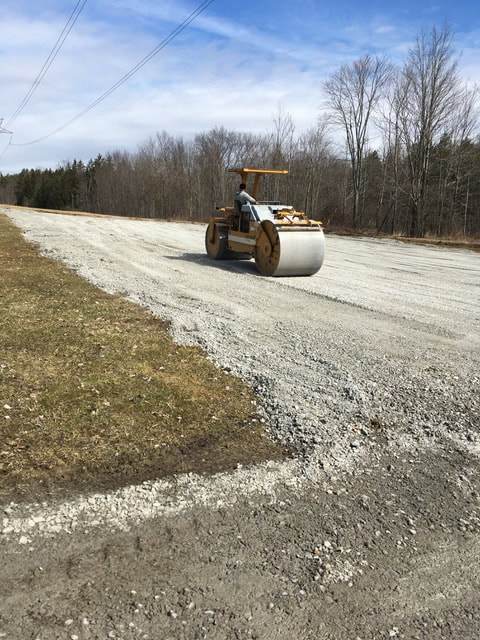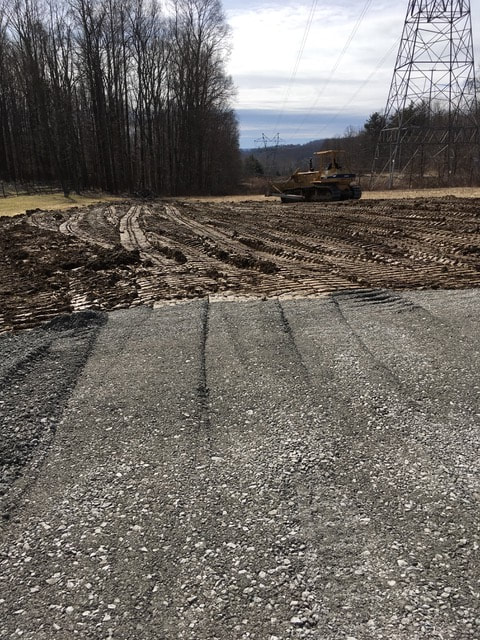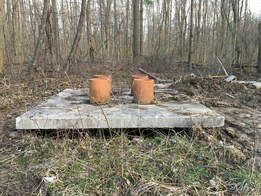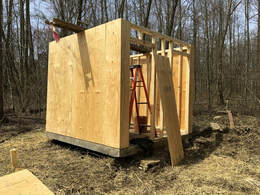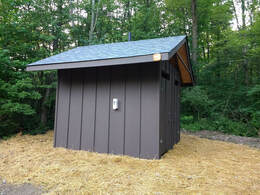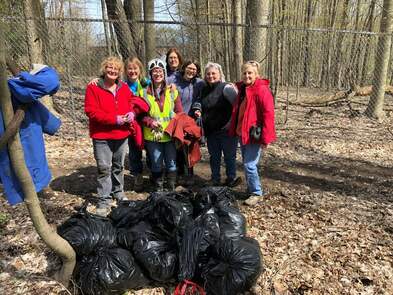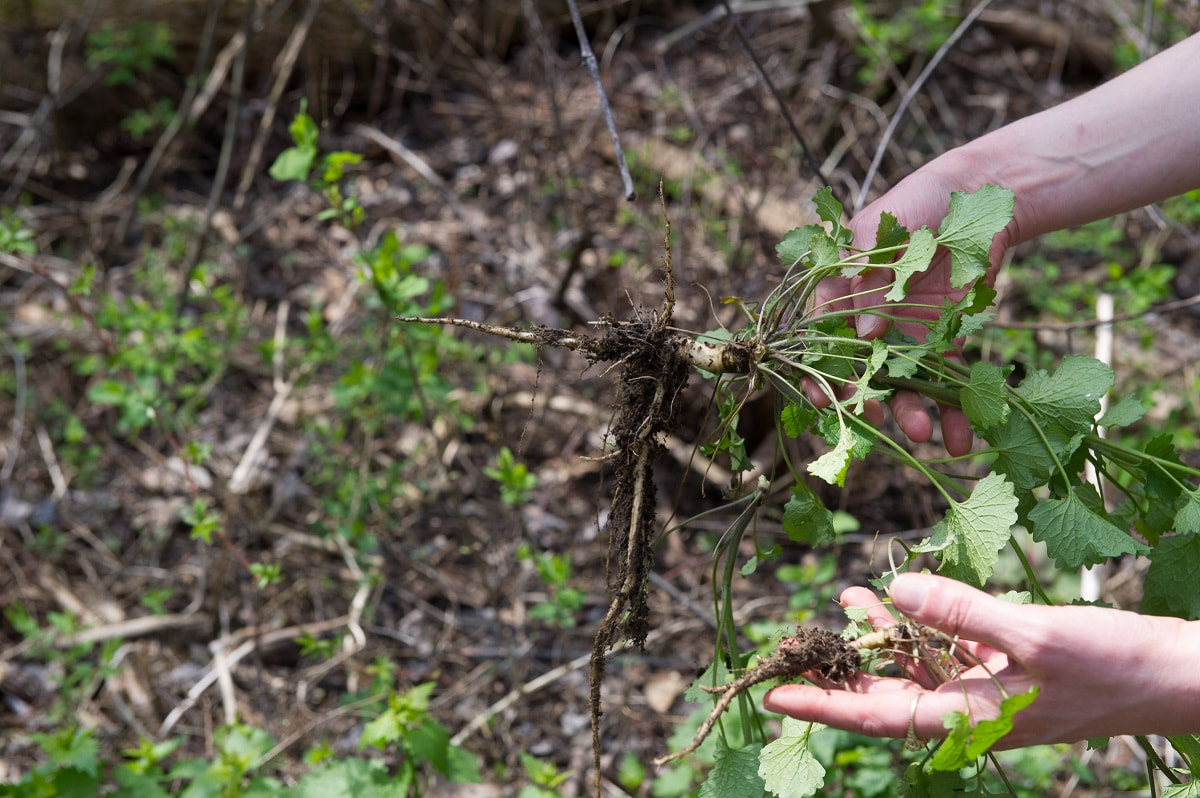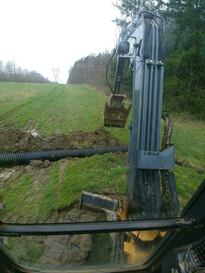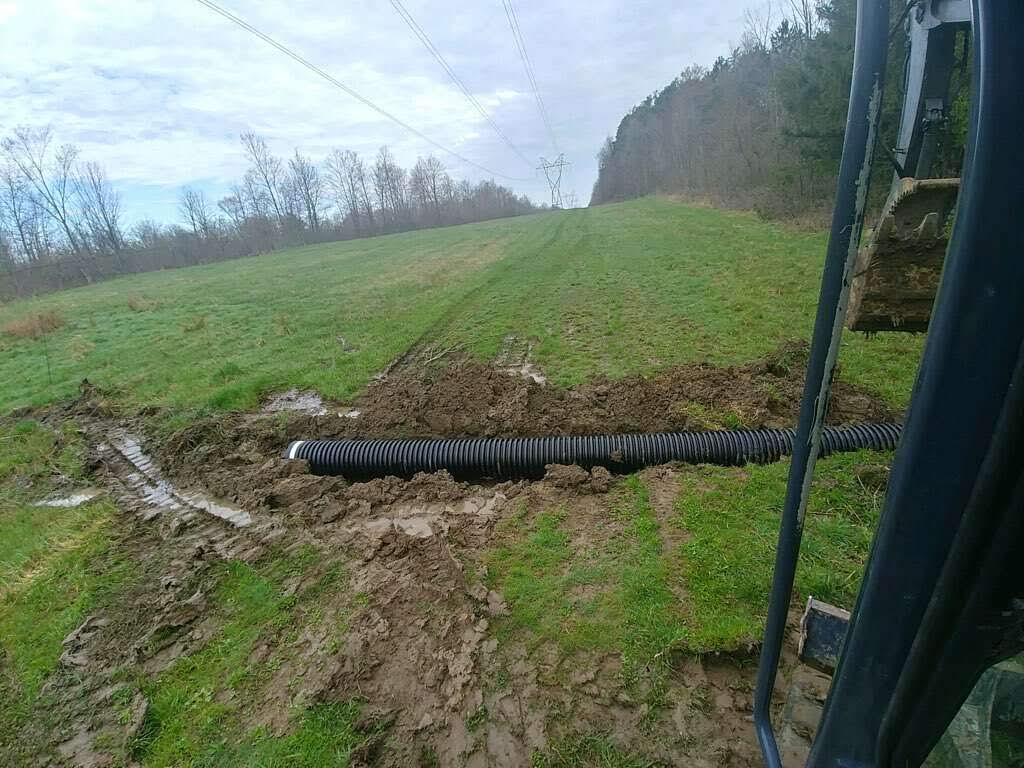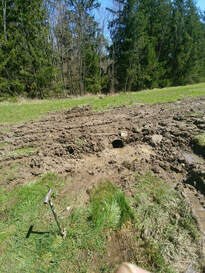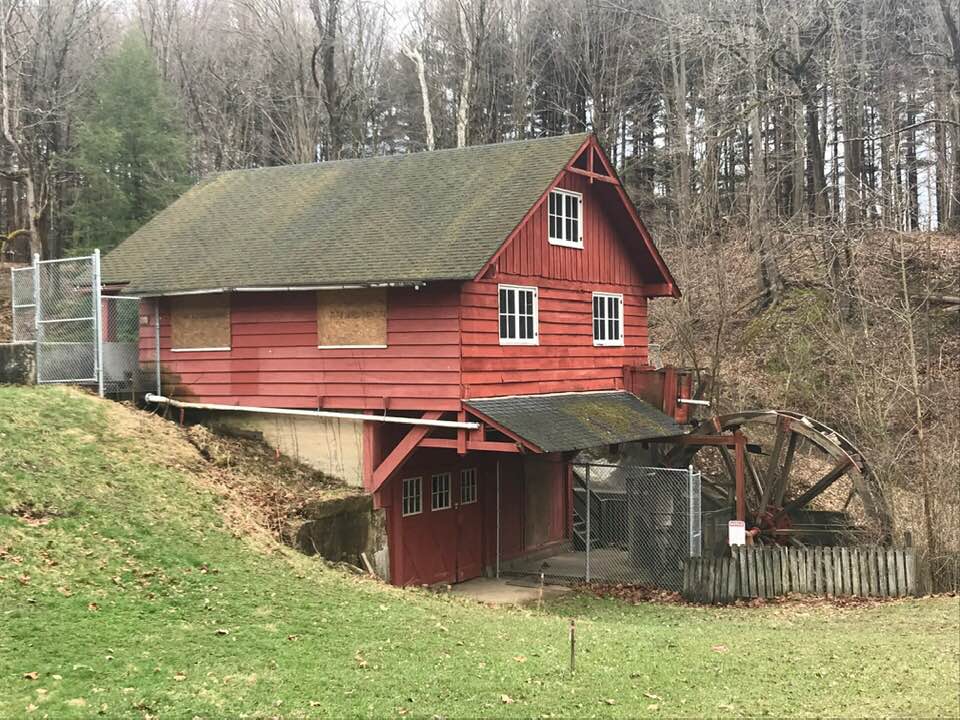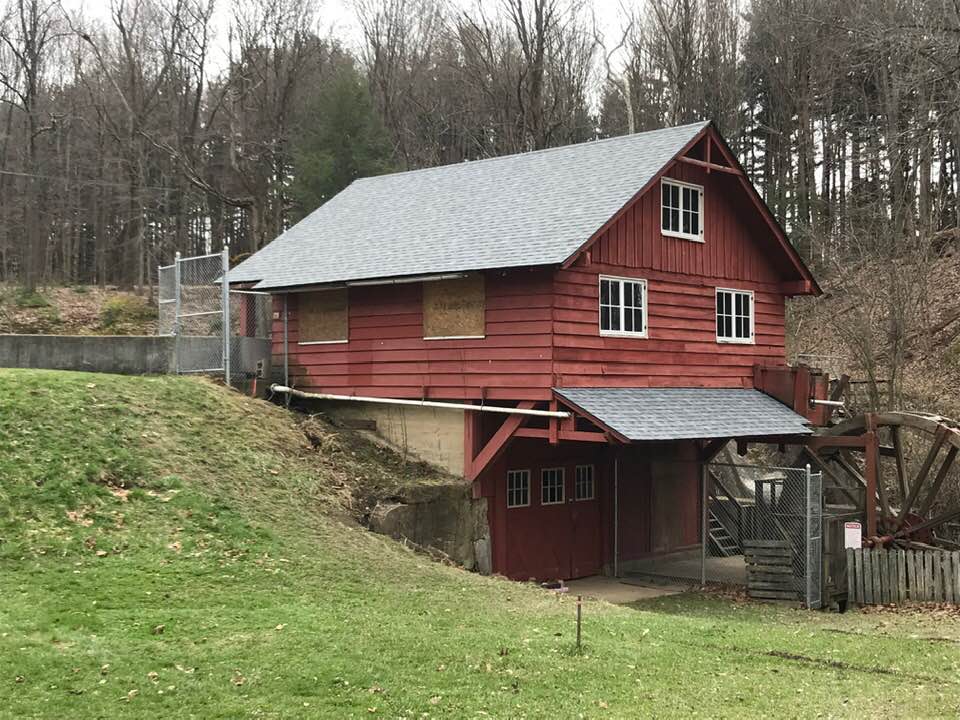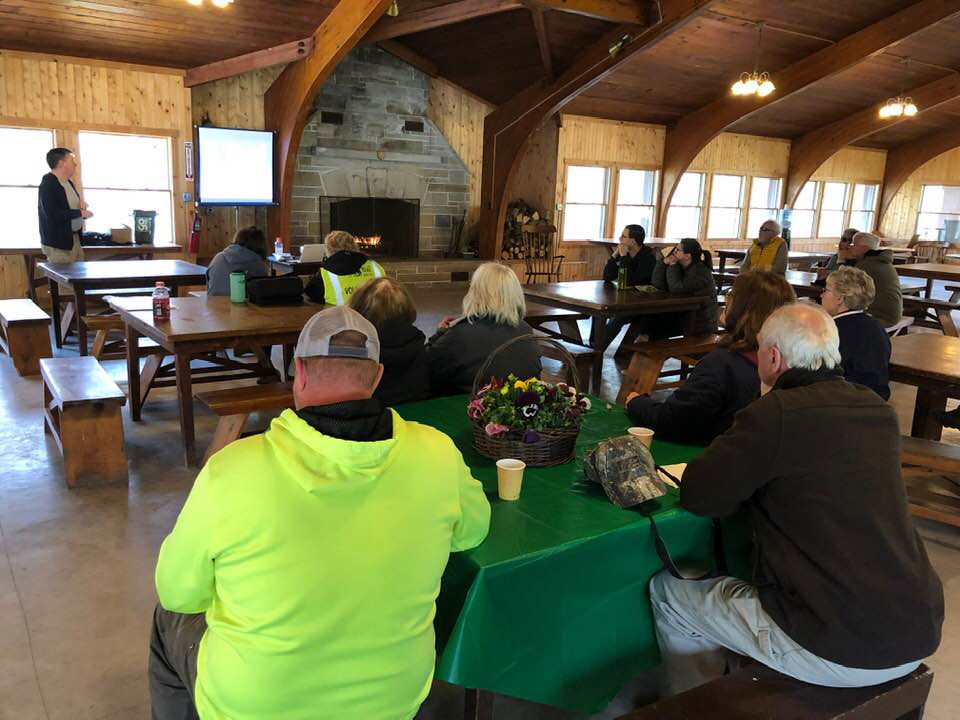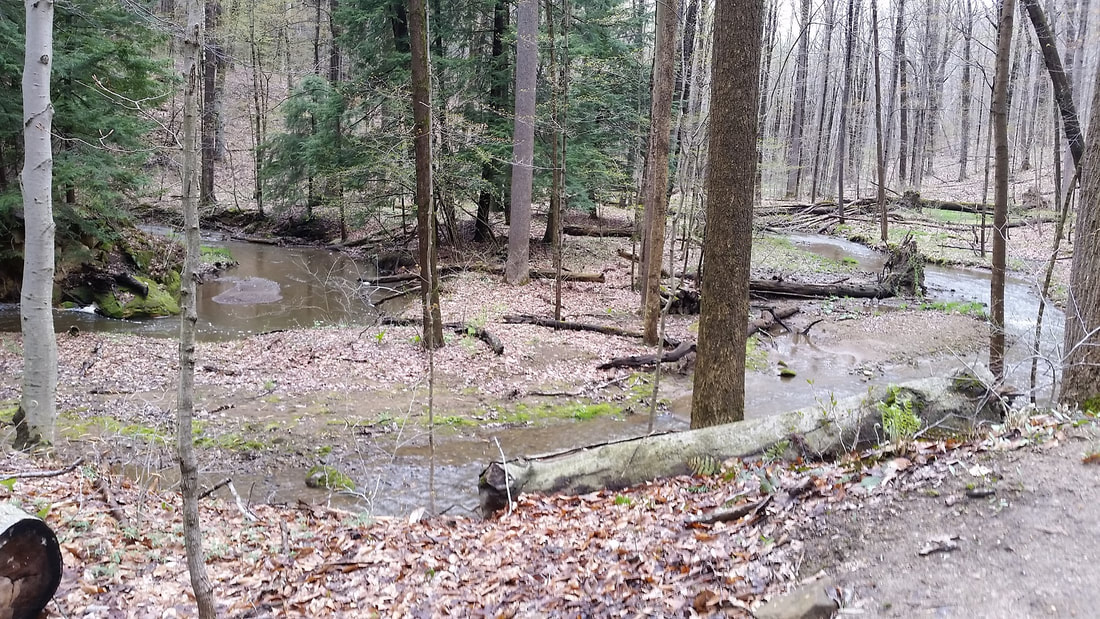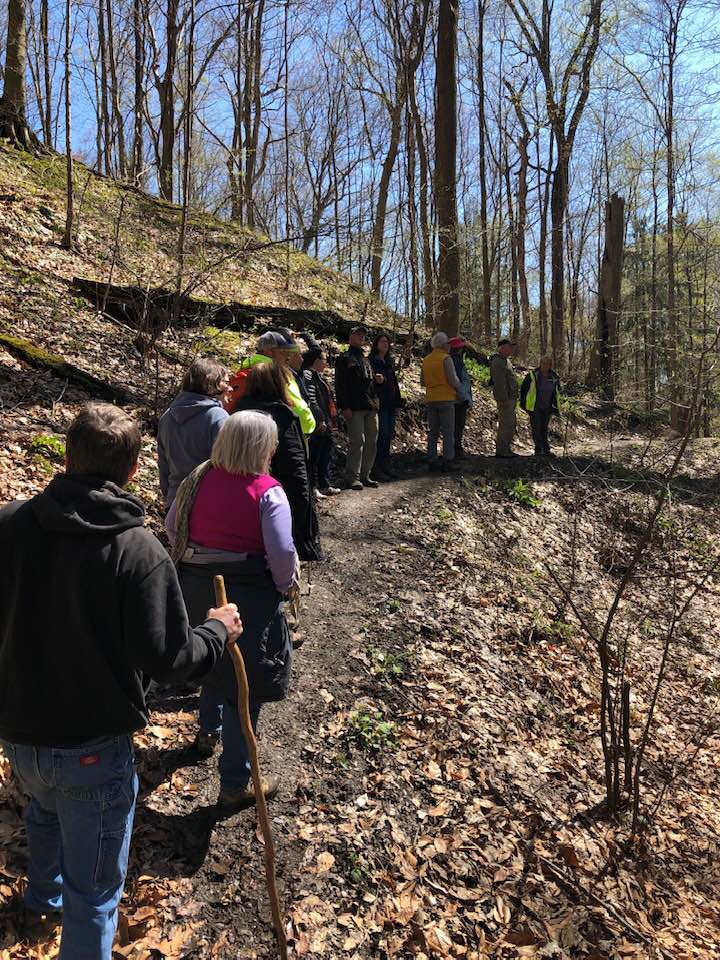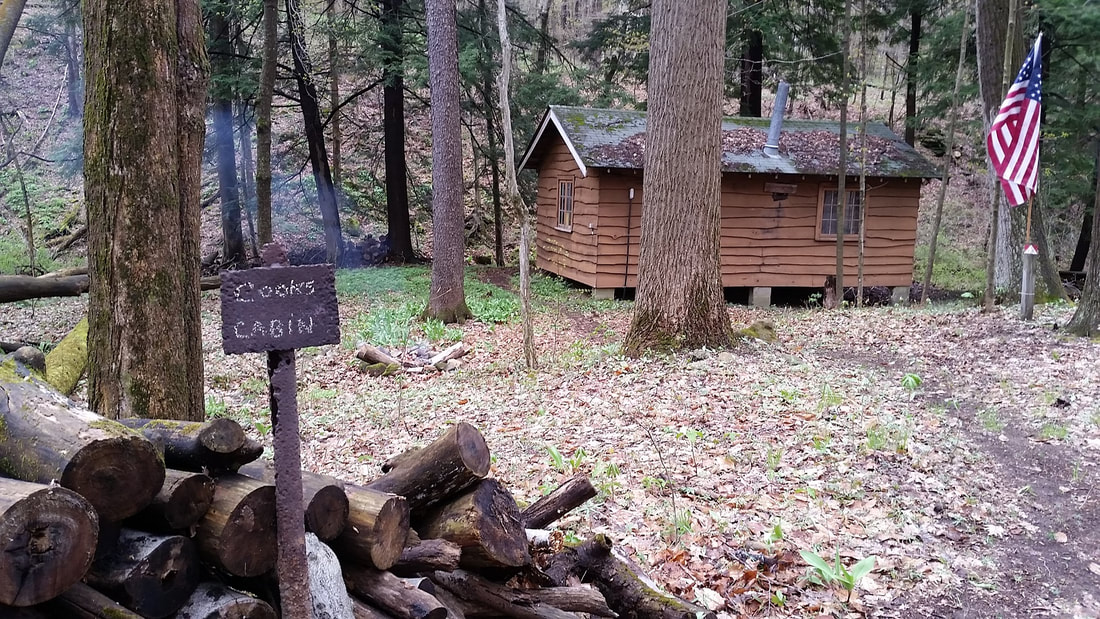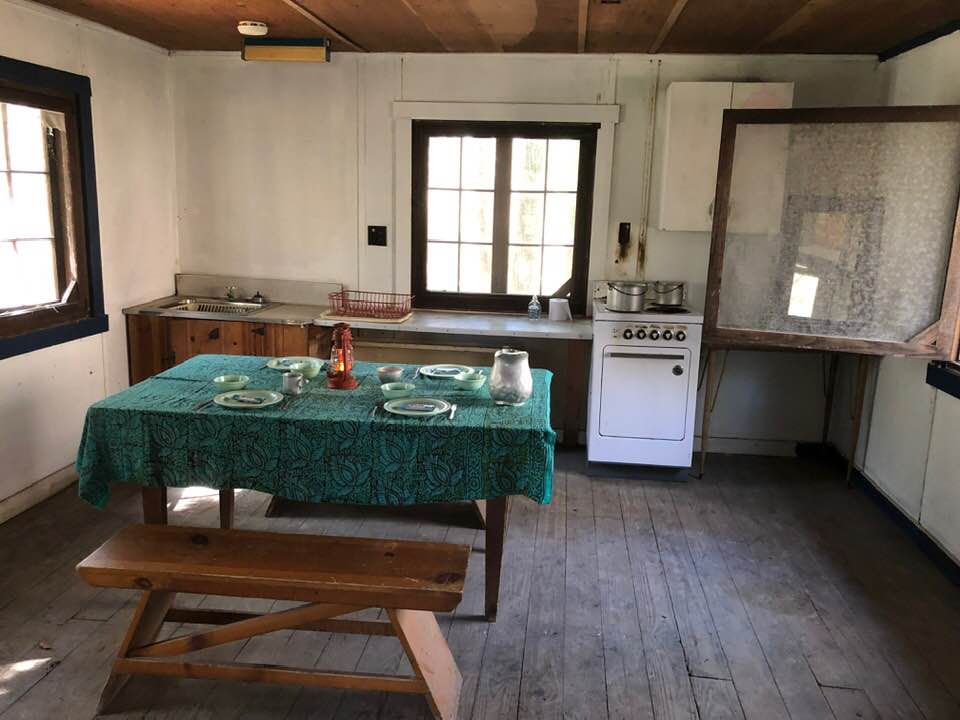What's Happening in 2019
DECEMBER 2019
WORK CONTINUES ON WWTP
Work on the park’s existing Waste Water Treatment Plant (WWTP) is nearing the end, with completion scheduled by the end of January 2020. This is the second major capital improvement in the park in 2019 - the first capital project being Phase I of the Lower Lake Dam rehabilitation, completed in October.
FoCH "WINTER WONDERS" EVENT RAISES FUNDS FOR RESTORATION OF KIRBY'S MILL

On Saturday, December 7, Friends of Crowell Hilaka (FoCH) held its “Cozy Up to Winter Wonders” annual cookie sale. This year, there was something for everyone – storytelling by the Richfield Library, crafts for the kids, guided hikes, horse-drawn wagon rides and of course, lots of cookies.
New this year, local artists sold their crafts including hand-made soaps, soft and cozy crochet hats and hand-blown glass ornaments and decorations. Attendees enjoyed a gourmet cocoa bar with hot and cold chocolate drinks along with a do-it-yourself S’mores station.
The 3rd annual holiday ornament, featuring Kirby’s Mill for 2019, was available for purchase. Each ornament is hand-painted by local artist R. Garlen Oviatt on re-purposed tent posts. Photographs of Richfield Heritage Preserve, taken by photographer Jim McClintock, were also sold. PHOTOS FROM THE EVENT . . .
Missed the event? Enjoy hot chocolate around the fire with FoCH on Sunday, December 15 and 22 from 2:00 p.m. to 4:00 p.m. in Gund Hall. Catch up with old friends and make new ones. Kirby's Mill promotional items will be available for purchase.
All proceeds from these events go towards the restoration of Kirby’s Mill, bringing us one step closer to turning the mill wheel once again. Donate here . . .
New this year, local artists sold their crafts including hand-made soaps, soft and cozy crochet hats and hand-blown glass ornaments and decorations. Attendees enjoyed a gourmet cocoa bar with hot and cold chocolate drinks along with a do-it-yourself S’mores station.
The 3rd annual holiday ornament, featuring Kirby’s Mill for 2019, was available for purchase. Each ornament is hand-painted by local artist R. Garlen Oviatt on re-purposed tent posts. Photographs of Richfield Heritage Preserve, taken by photographer Jim McClintock, were also sold. PHOTOS FROM THE EVENT . . .
Missed the event? Enjoy hot chocolate around the fire with FoCH on Sunday, December 15 and 22 from 2:00 p.m. to 4:00 p.m. in Gund Hall. Catch up with old friends and make new ones. Kirby's Mill promotional items will be available for purchase.
All proceeds from these events go towards the restoration of Kirby’s Mill, bringing us one step closer to turning the mill wheel once again. Donate here . . .
NOVEMBER 2019
RIBBON-CUTTING CEREMONY MARKS COMPLETION OF PHASE I LOWER LAKE DAM PROJECT
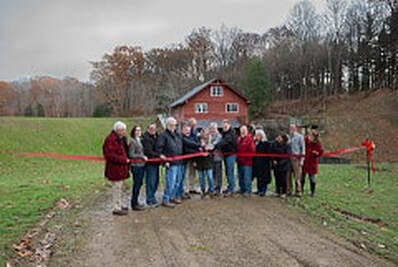 RJRD board and staff along with Gannett Fleming and Black Horse Construction representatives
RJRD board and staff along with Gannett Fleming and Black Horse Construction representatives
On Saturday, November 23, the RJRD board along with representatives from Gannett Fleming and Black Horse Construction held a ribbon-cutting ceremony to celebrate the completion of Phase I of the Lower Lake Dam Rehabilitation project.
Richfield residents were invited for light refreshments in Gund Hall after the ceremony. MORE >>>
The restoration of the lower lake dam was needed to protect Lake Jinelle. Lake Jinelle is the world's only known patented lake. Jim Kirby, inventor and owner of more than 160 patents, designed the lake to remain clear for fishing, swimming and boating. Silt accumulation was minimized along with the need for periodic dredging.
How did Lake Jinelle get its name? Kirby combined his first name, "Jim" with his wife's first name, “Nellie”, resulting in “Jinelle”.
Learn MORE (short video) about Lake Jinelle and the restoration project >>>
Richfield residents were invited for light refreshments in Gund Hall after the ceremony. MORE >>>
The restoration of the lower lake dam was needed to protect Lake Jinelle. Lake Jinelle is the world's only known patented lake. Jim Kirby, inventor and owner of more than 160 patents, designed the lake to remain clear for fishing, swimming and boating. Silt accumulation was minimized along with the need for periodic dredging.
How did Lake Jinelle get its name? Kirby combined his first name, "Jim" with his wife's first name, “Nellie”, resulting in “Jinelle”.
Learn MORE (short video) about Lake Jinelle and the restoration project >>>
WORK CONTINUES ON WWTP
Improvements to the park’s existing Waste Water Treatment Plant (WWTP) continue with the project scheduled for completion by the end of January 2020.
STRONGSVILLE ROTC SUPPORTS RICHFIELD HERITAGE PRESERVE
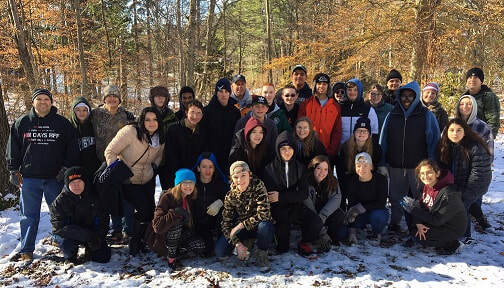 Strongsville Air Force Junior ROTC
Strongsville Air Force Junior ROTC
On November 16, 2019, thirty-one young men and women from the Strongsville Air Force Junior ROTC made a significant impact at Richfield Heritage Preserve.
The crew divided into groups to complete a variety of projects to help prepare the park for the winter months.
In a short amount of time, the group moved picnic tables and heavy hay bales to the shelters and moved large sections of cut trees to the saw mill.
We are very grateful to the Strongsville Air Force Junior ROTC for their continued support of the park.
The crew divided into groups to complete a variety of projects to help prepare the park for the winter months.
In a short amount of time, the group moved picnic tables and heavy hay bales to the shelters and moved large sections of cut trees to the saw mill.
We are very grateful to the Strongsville Air Force Junior ROTC for their continued support of the park.
IMPROVEMENTS TO WASTE WATER TREATMENT PLANT ABOUT TO BEGIN
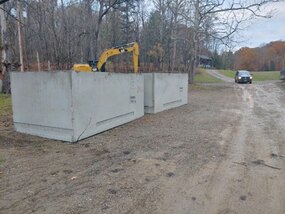
Improvements to the park’s existing Waste Water Treatment Plant (WWTP) are about to begin. These improvements are vital to the continued operation of Richfield Heritage Preserve. Bid requests were posted, responses received and reviewed, and the winning bid awarded in April to Workman Industrial Services, Inc.
Improvements to the WWTP include replacing the existing pump station and adding a power-loss alarm system which would provide a local visual alarm if utility power serving the WWTP is lost, notifying operation personnel of the condition. The new WWTP will connect the buildings to a sewer system, essential for park operations. READ FULL ARTICLE >>>
Improvements to the WWTP include replacing the existing pump station and adding a power-loss alarm system which would provide a local visual alarm if utility power serving the WWTP is lost, notifying operation personnel of the condition. The new WWTP will connect the buildings to a sewer system, essential for park operations. READ FULL ARTICLE >>>
OCTOBER 2019
RICHFIELD HERITAGE PRESERVE AWARDED RTCA GRANT
Richfield Heritage Preserve was awarded a technical assistance grant from the National Park Service Rivers, Trails and Conservation Assistance (RTCA) program. Its programs support community-led natural resource conservation and outdoor recreation projects across the nation. The grant includes a year of assistance during the 2020 federal fiscal year, beginning October 1, 2019, and ending September 30, 2020.
This initiative will help us engage our community in growing and protecting Richfield Heritage Preserve through a community-driven planning process. We are so fortunate to have this incredible resource available to us on the heels of the ANCA consult.
RTCA ACCEPTANCE LETTER
This initiative will help us engage our community in growing and protecting Richfield Heritage Preserve through a community-driven planning process. We are so fortunate to have this incredible resource available to us on the heels of the ANCA consult.
RTCA ACCEPTANCE LETTER
BRIDGE REPAIR KEEPS TRAIL SAFE
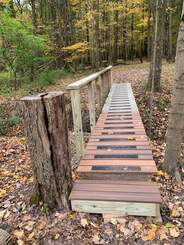
In October 2019, volunteers made necessary repairs to a bridge that was installed over the creek south of the gas cut, east of High Lea shelter. Though the bridge itself was in excellent condition, it had shifted and dropped from its position due to erosion, making this section of the trail difficult to maneuver.
Volunteers shored up the existing bridge and connected it to a newly constructed section. The completed bridge now extends an additional five to six feet on each end and is secured to more stable ground. Slip resistant strips and a hand rail were added for additional safety.
Thank you to the volunteer energy along with the donation of all materials that went into making this section of the trail safe to explore once again.
LOWER LAKE DAM RESTORATION PROJECT COMES TO SUCCESSFUL COMPLETION
Phase I of the Richfield Heritage Preserve lower lake dam restoration project was completed in October. The Ohio Department of Natural Resources gave its approval to install this unique dam armoring technique -- a first in the state of Ohio. READ ENTIRE ARTICLE plus MORE PICTURES >>>
COMMUNITY CELEBRATION - SATURDAY, NOVEMBER 23, 2:00 p.m. at Gund Hall.
COMMUNITY CELEBRATION - SATURDAY, NOVEMBER 23, 2:00 p.m. at Gund Hall.
'TRICK OR TREAT ON THE TRAIL' HAS RECORD ATTENDANCE
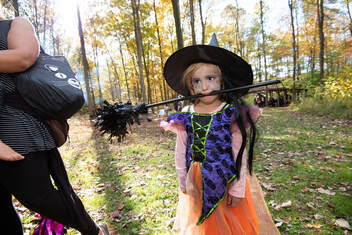 More candy please . . .
More candy please . . .
On Sunday, October 20, more than 1,500 trick-or-treaters of all ages attended the 4th 'Trick or Treat on the Trail' at Richfield Heritage Preserve. Dressed in their prettiest, scariest and very creative costumes, kids of all ages spent the afternoon asking for candy and playing games along the trail. Other activities included rock painting, leaf rubbing, face painting, bouncy horses and story telling. Click here for PHOTO SLIDE SHOW . . .
This event wouldn’t have been possible without our generous sponsors, event partners, donors and of course, all of our volunteers who made this event a special day to remember.
SPONSORS: NPK Construction Equipment, Inc.; Countryside Florist; Frontier Tank Center; National Interstate Insurance; Broadview Insurance Agency; D.B. Johnsen Company; Seifert & Cox, L.L.P.; Village Auto Body; Michael & Polly Wheeler; Winar Connection, Inc.; Beltone Hearing; Gonzales Family; 1Direction, Inc.; Paws Awhile Pet Memorial Park; Richfield Chiropractic Center; Richfield Historical Society
EVENT PARTNERS: Boy Scouts; Friends of Crowell Hilaka; Ohio Horseman's Council; Pink Velvet Art Studio (located in Richfield); Revere High School art students; Richfield Branch Library; and Western Reserve Land Conservancy
DONATIONS: Jim Culler; Great Grins Photo Booth; Luther Farms; and Western Reserve Limousine
This event wouldn’t have been possible without our generous sponsors, event partners, donors and of course, all of our volunteers who made this event a special day to remember.
SPONSORS: NPK Construction Equipment, Inc.; Countryside Florist; Frontier Tank Center; National Interstate Insurance; Broadview Insurance Agency; D.B. Johnsen Company; Seifert & Cox, L.L.P.; Village Auto Body; Michael & Polly Wheeler; Winar Connection, Inc.; Beltone Hearing; Gonzales Family; 1Direction, Inc.; Paws Awhile Pet Memorial Park; Richfield Chiropractic Center; Richfield Historical Society
EVENT PARTNERS: Boy Scouts; Friends of Crowell Hilaka; Ohio Horseman's Council; Pink Velvet Art Studio (located in Richfield); Revere High School art students; Richfield Branch Library; and Western Reserve Land Conservancy
DONATIONS: Jim Culler; Great Grins Photo Booth; Luther Farms; and Western Reserve Limousine
ON THE WINGS OF CONSERVATION
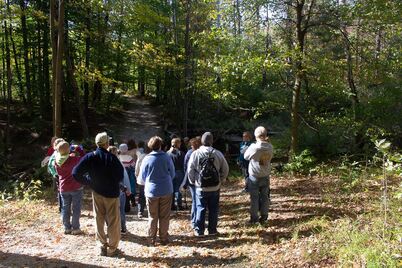 Learning about migrating birds and conservation efforts
Learning about migrating birds and conservation efforts
Friends of Crowell Hilaka (FoCH) hosted its fourth and final themed hike for the season on October 13 titled “On the Wings of Conservation”.
Ohio is known for its migrating birds and Richfield Heritage Preserve provides a wonderful home for our feathered friends. Attendees brought their binoculars in the hopes of spotting some of the finest birds in this region. After the hike, Tom Romito of the Western Cuyahoga Audubon Society made a presentation.
Attendees also learned about conservation efforts being made in the park to remove invasive species, replacing them with native plants. Light refreshments followed the hike.
FoCH hosted four hikes throughout 2019, each focused on a different topic - recreation, history, education and conservation. FoCH is currently working on its schedule of themed hikes for 2020, so stay tuned.
Ohio is known for its migrating birds and Richfield Heritage Preserve provides a wonderful home for our feathered friends. Attendees brought their binoculars in the hopes of spotting some of the finest birds in this region. After the hike, Tom Romito of the Western Cuyahoga Audubon Society made a presentation.
Attendees also learned about conservation efforts being made in the park to remove invasive species, replacing them with native plants. Light refreshments followed the hike.
FoCH hosted four hikes throughout 2019, each focused on a different topic - recreation, history, education and conservation. FoCH is currently working on its schedule of themed hikes for 2020, so stay tuned.
SEPTEMBER 2019
PEER CONSULTATION HELPS SET POSITIVE DIRECTION

The Richfield Joint Recreation District and Friends of Crowell Hilaka worked together to secure a $2,250 scholarship for a peer consultation with the Association of Nature Center Administrators (ANCA). ANCA is an international non-profit organization that promotes and supports best leadership and management practices for the nature and environmental learning center profession.
From September 26 through 28, 2019, the ANCA Peer Consult Team provided an intensive examination of the two groups focusing on ways to improve (1) internal communication and relationships between their organizations in an effort to build a strong organizational structure; (2)community engagement and exploring educational and recreational programming to build community support; and (3) planning with a focus on the actual planning process, realistic timelines, budgets, expectations, prioritizing and goal setting.
Much of the time was also spent meeting with key stakeholders including residents, volunteers, park partner groups, local business owners and community leaders. From these conversations, the ANCA Peer Consult Team developed a series of realistic and necessary recommendations that are within the ability of both organizations to accomplish and will place both organizations in the best position to fulfill their missions. FULL REPORT >>>
From September 26 through 28, 2019, the ANCA Peer Consult Team provided an intensive examination of the two groups focusing on ways to improve (1) internal communication and relationships between their organizations in an effort to build a strong organizational structure; (2)community engagement and exploring educational and recreational programming to build community support; and (3) planning with a focus on the actual planning process, realistic timelines, budgets, expectations, prioritizing and goal setting.
Much of the time was also spent meeting with key stakeholders including residents, volunteers, park partner groups, local business owners and community leaders. From these conversations, the ANCA Peer Consult Team developed a series of realistic and necessary recommendations that are within the ability of both organizations to accomplish and will place both organizations in the best position to fulfill their missions. FULL REPORT >>>
OSWALD COMPANIES DAY OF CARING AT RICHFIELD HERITAGE PRESERVE
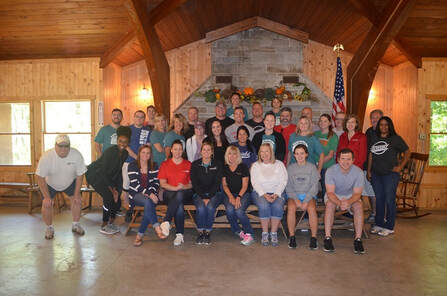 Oswald Companies Day of Caring
Oswald Companies Day of Caring
Approximately 50 Oswald Companies employees spent the afternoon of September 27 at Richfield Heritage Preserve as part of Oswald’s Day of Caring community program. Oswald Companies is one of the nation’s largest independent insurance brokerage and risk management firms. Their Day of Caring started approximately 16 years ago as a way to reinforce their core value of commitment to community.
Oswald employees split into teams to undertake several projects at the park. The first team painted the exterior of Gund Hall, the second cleared park trails, the third cleaned the Waterfront Shelter roof, and the fourth cleaned the interior of Chagrin Cabin.
Two representatives from P.A.L.S. for Healing, (Paper. Art Therapy. Letting Go. Self Actualization), a nonprofit organization that seeks to empower individuals and families who have suffered trauma or loss, oversaw a fifth team of Oswald employees. That team prepared craft materials to be used for children’s art therapy through the following organizations: Supporting Kids with Incarcerated Parents, Military Families Support Group, and children’s school groups.
Within three hours, the group made a significant impact at Richfield Heritage Preserve that is sincerely appreciated by the RJRD Board as well as park guests. Oswald employees worked together on a common goal and experienced instant gratification from the completion of their projects at the park. And, if all this hard work wasn't enough, they presented the RJRD Board with a monetary donation for the park.
Oswald employees split into teams to undertake several projects at the park. The first team painted the exterior of Gund Hall, the second cleared park trails, the third cleaned the Waterfront Shelter roof, and the fourth cleaned the interior of Chagrin Cabin.
Two representatives from P.A.L.S. for Healing, (Paper. Art Therapy. Letting Go. Self Actualization), a nonprofit organization that seeks to empower individuals and families who have suffered trauma or loss, oversaw a fifth team of Oswald employees. That team prepared craft materials to be used for children’s art therapy through the following organizations: Supporting Kids with Incarcerated Parents, Military Families Support Group, and children’s school groups.
Within three hours, the group made a significant impact at Richfield Heritage Preserve that is sincerely appreciated by the RJRD Board as well as park guests. Oswald employees worked together on a common goal and experienced instant gratification from the completion of their projects at the park. And, if all this hard work wasn't enough, they presented the RJRD Board with a monetary donation for the park.
AMITY HOUSE - PRESERVING A TREASURE
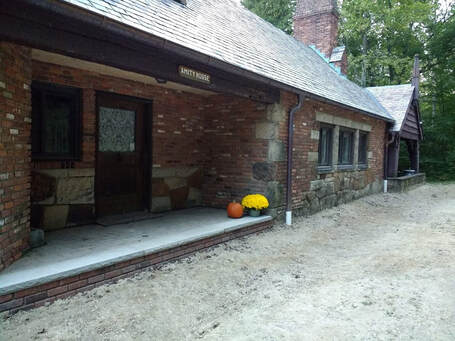 New brick and sandstone step treads complete the porch
New brick and sandstone step treads complete the porch
Over several weekends in September, volunteers worked together to stabilize the foundation of Amity House. Water from heavy rains and melting snow had been saturating the foundation for years, causing damage to the foundation and water seepage into the basement. To stop this problem, a culvert was dug along the wall to the main entrance in order to keep any flow of water from heavy rains moving along the ditch and away from the house. The failing entrance porch floor was repaired by installing new brick and sandstone step treads, replicating the original material and design.
Next, volunteers moved inside to the basement where they erected temporary braces to support the existing joists. Sections of rotted joists were removed followed by the installation of a new rim joist along this same wall to provide lateral support for the new joists. Once the rim joist was installed, existing weak floor joists were sistered - beefing them up - by adding framing lumber to each side of the existing joist to strengthen it and help straighten any sagging. Once in place, carriage bolts were installed to permanently secure the new joists.
This labor of love was completed with volunteer energy along with the donation of 100% of the materials needed to complete the project. Amity House is now safe from the elements until its final use is determined sometime in the future.
Next, volunteers moved inside to the basement where they erected temporary braces to support the existing joists. Sections of rotted joists were removed followed by the installation of a new rim joist along this same wall to provide lateral support for the new joists. Once the rim joist was installed, existing weak floor joists were sistered - beefing them up - by adding framing lumber to each side of the existing joist to strengthen it and help straighten any sagging. Once in place, carriage bolts were installed to permanently secure the new joists.
This labor of love was completed with volunteer energy along with the donation of 100% of the materials needed to complete the project. Amity House is now safe from the elements until its final use is determined sometime in the future.
FUN FACT:
Don’t be fooled by the date on the pillar that stands to the side of the porch fireplace of Amity House. Though the carving shows 1867, Amity House was built by Herbert and Helen Neal in 1936. The pillar is a re-purposed gatepost from the Freeman farm where the Neal's lived when they first moved to Richfield in 1918.
Don’t be fooled by the date on the pillar that stands to the side of the porch fireplace of Amity House. Though the carving shows 1867, Amity House was built by Herbert and Helen Neal in 1936. The pillar is a re-purposed gatepost from the Freeman farm where the Neal's lived when they first moved to Richfield in 1918.
LOWER LAKE DAM REHABILITATION PROJECT - ABS INSTALLATION
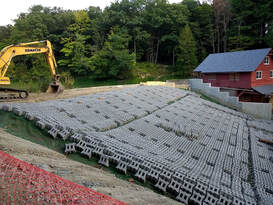 ABS Installation
ABS Installation
We are in the home stretch of Phase I of the lower lake dam rehabilitation project.
With clearing, grubbing and concrete work complete, work began on the next stage of construction.
Learn more about the step-by-step installation of the Articulated Block System (ABS) - an economical design solution proven to be an aesthetic and functional alternative to traditional solutions such as dumped stone riprap, structural concrete and other heavy-duty erosion protection systems -- a first in the state of Ohio.
READ ENTIRE ARTICLE plus MORE PICTURES >>>
With clearing, grubbing and concrete work complete, work began on the next stage of construction.
Learn more about the step-by-step installation of the Articulated Block System (ABS) - an economical design solution proven to be an aesthetic and functional alternative to traditional solutions such as dumped stone riprap, structural concrete and other heavy-duty erosion protection systems -- a first in the state of Ohio.
READ ENTIRE ARTICLE plus MORE PICTURES >>>
KIRBY DAY "MARBLE-OUS MILL" EVENT
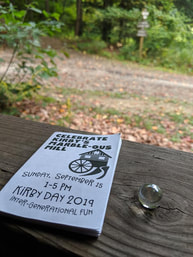 Participants received a clue book and one marble to begin
Participants received a clue book and one marble to begin
The Friends of Crowell Hilaka (FoCH) hosted its 5th annual Kirby Day event themed “Marble-ous Mill” on Sunday, September 15 from 1:00 p.m. to 5:00 p.m. at Richfield Heritage Preserve. Close to 300 attendees enjoyed a day of treasuring hunting, good food and learning more about the park.
Participants of the treasure hunt each received a book of clues that led them through the park to hidden letterboxes filled with marbles. Once the letterbox was found, the participant took one marble from the box then used the ink stamp found in the box to mark their clue book – similar to a passport. Along the way, marble games and various contraptions were hidden throughout the park inviting participants to stop and play.
Participants returned to Gund Hall with their new found treasure to learn the game of marbles taught by Michael Cohill of the American Toy Marble Museum.
Grilled hot dogs, cookies and other snacks along with marble-ous souvenirs were available for purchase with all funds going towards the restoration of Kirby’s Mill. Once this landmark – as listed on the National Register of Historic Places – is restored, an innovation from the past will provide inspiration to future generations.
Participants of the treasure hunt each received a book of clues that led them through the park to hidden letterboxes filled with marbles. Once the letterbox was found, the participant took one marble from the box then used the ink stamp found in the box to mark their clue book – similar to a passport. Along the way, marble games and various contraptions were hidden throughout the park inviting participants to stop and play.
Participants returned to Gund Hall with their new found treasure to learn the game of marbles taught by Michael Cohill of the American Toy Marble Museum.
Grilled hot dogs, cookies and other snacks along with marble-ous souvenirs were available for purchase with all funds going towards the restoration of Kirby’s Mill. Once this landmark – as listed on the National Register of Historic Places – is restored, an innovation from the past will provide inspiration to future generations.
FUN FACT:
Letterboxing is an outdoor hobby that combines elements of orienteering and puzzle solving where participants follow clues to find small, weatherproof boxes in publicly accessible places. The first letter box was patented on March 9, 1858 by Albert Potts.
Letterboxing is an outdoor hobby that combines elements of orienteering and puzzle solving where participants follow clues to find small, weatherproof boxes in publicly accessible places. The first letter box was patented on March 9, 1858 by Albert Potts.
AUGUST 2019
NATIVE PLANT RESTORATION PROJECT
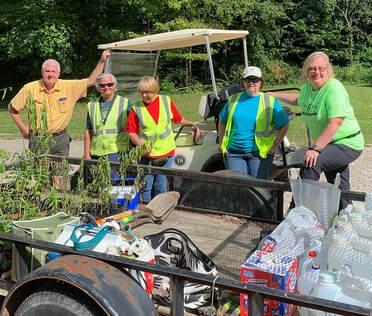 Our hard working volunteers
Our hard working volunteers
On Thursday, August 29, the Friends of Crowell Hilaka, the friends’ group for Richfield Heritage Preserve, along with representatives from the National Wildlife Foundation (NWF) planted close to 100 native plants in areas along Crescent Trail, near the lower lake across from Garfield Hall and in the woodland edge by the south doors (forest edge) of Gund Hall.
Plants used in the restoration project included swamp milkweed, great blue lobelia and obedient plants. These plants all do well in wetlands but will also grow well in medium moist conditions once established. The nectar and pollen of the flowers primarily attracts bumblebees and other long-tongued bees as well as hummingbirds and butterflies. These good pollinators will help increase the presence of native species back into the park.
Swamp milkweed is not invasive like other milkweeds and is well behaved once planted. It is a necessity of Monarch butterflies and, in fact, Monarchs cannot survive without it; their caterpillars only eat milkweed plants and the butterflies need milkweed to lay their eggs. Unfortunately, with shifting land management practices, much milkweed has been lost from the landscape so we are helping Mother Nature by adding it into the park. As an added bonus, some of these plants had already attracted Monarch caterpillars while waiting to be transported to the park.
Great blue lobelia plants form colonies of deep blue flower spikes in late summer and early fall. The Obedient plant develops tall spikes of pretty trumpet-like pink, purple or white flowers in four neat vertical rows, and begin opening from the bottom up in the late summer and early fall.
This native plant restoration project helps the environment and keeps the Richfield Joint Recreation District (RJRD) in compliance with its Clean Ohio and Western Reserve Land Conservancy management agreement requirements.
Thank you to our volunteers for all their hard work that is helping make Richfield Heritage Preserve even more beautiful.
Plants used in the restoration project included swamp milkweed, great blue lobelia and obedient plants. These plants all do well in wetlands but will also grow well in medium moist conditions once established. The nectar and pollen of the flowers primarily attracts bumblebees and other long-tongued bees as well as hummingbirds and butterflies. These good pollinators will help increase the presence of native species back into the park.
Swamp milkweed is not invasive like other milkweeds and is well behaved once planted. It is a necessity of Monarch butterflies and, in fact, Monarchs cannot survive without it; their caterpillars only eat milkweed plants and the butterflies need milkweed to lay their eggs. Unfortunately, with shifting land management practices, much milkweed has been lost from the landscape so we are helping Mother Nature by adding it into the park. As an added bonus, some of these plants had already attracted Monarch caterpillars while waiting to be transported to the park.
Great blue lobelia plants form colonies of deep blue flower spikes in late summer and early fall. The Obedient plant develops tall spikes of pretty trumpet-like pink, purple or white flowers in four neat vertical rows, and begin opening from the bottom up in the late summer and early fall.
This native plant restoration project helps the environment and keeps the Richfield Joint Recreation District (RJRD) in compliance with its Clean Ohio and Western Reserve Land Conservancy management agreement requirements.
Thank you to our volunteers for all their hard work that is helping make Richfield Heritage Preserve even more beautiful.
FUN FACT:
Obedient Plant got its name because you can bend the individual flowers in any direction. Obedient Plant has another common name, False Dragonhead, which likely came about because of the flowers' resemblance to snapdragons.
Obedient Plant got its name because you can bend the individual flowers in any direction. Obedient Plant has another common name, False Dragonhead, which likely came about because of the flowers' resemblance to snapdragons.
A DIG INTO THE PAST
Friends of Crowell Hilaka (FoCH) hosted its third themed hike for the season on August 25, titled “A Dig into the Past”. Dr. Phil Wanyerka, Associate College Lecturer for the Department of Criminology, Anthropology, and Sociology, Cleveland State University, led close to 75 attendees through Richfield Heritage Preserve, stopping along the way to share artifacts from his collection.
A special treat for attendees was the opportunity to use an atlatl - a stick with a handle and hook on one end that engages a light spear on the opposite end. The flipping motion of the atlatl propels a light spear much faster and farther than it could be thrown by hand alone.
FoCH is hosting four hikes throughout the year, each focused on a different topic -- recreation, history, education and conservation.
Missed this hike? Don’t worry. One more hike is scheduled for October 13 (Conservation – “On the Wings of Conservation”).
A special treat for attendees was the opportunity to use an atlatl - a stick with a handle and hook on one end that engages a light spear on the opposite end. The flipping motion of the atlatl propels a light spear much faster and farther than it could be thrown by hand alone.
FoCH is hosting four hikes throughout the year, each focused on a different topic -- recreation, history, education and conservation.
Missed this hike? Don’t worry. One more hike is scheduled for October 13 (Conservation – “On the Wings of Conservation”).
LOWER LAKE DAM REHABILITATION PROJECT WEEKS 6 and 7
The weeks of August 5 and 12 marked the sixth and seventh weeks of construction for Phase I of the lower lake dam rehabilitation project. Rough grading, preliminary road layout and concrete work continued. Read about the entire project here.
ROCKING IN THE TREETOPS ALL DAY LONG
HOPPIN' AND A-BOPPIN' AND SINGING A SONG
HOPPIN' AND A-BOPPIN' AND SINGING A SONG
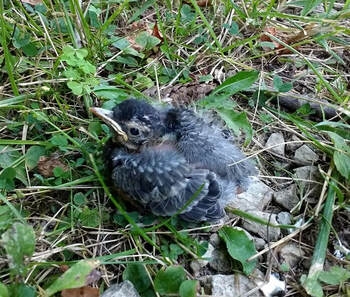 Taking a break in Richfield Heritage Preserve
Taking a break in Richfield Heritage Preserve
Look who we found taking a break in Richfield Heritage Preserve – a baby American robin! This little feather-ball is learning to fly and decided to rest between flights.
Robins are monogamous breeders, with breeding activity peaking in April, June and July. The young incubate for 13 days, leaving the nest just two weeks later. Fledglings are able to fly short distances after leaving the nest. The wings of juvenile birds develop rapidly, taking only a couple of weeks to become proficient at flying.
Robins breed and nest in virtually any mowed area with suitable nesting sites nearby, ranging from trees to buildings and even on fence posts. The female constructs the nest and incubates the eggs. Males help rear the nestlings and fledglings by providing food. The male's feeding role is more prominent late into the rearing of the first brood, as the female has diverted her attention to building a nest for the next brood. In a typical year, robins produce two broods of three to four eggs, although three broods are not uncommon.
Robins are social birds that, when not breeding, will roost communally with other robins and occasionally with starlings and blackbirds.
By the time the picture was taken, this little “king of the worm” had already taken off, testing its little wings once again. At the same time, the adult robin was active in protecting its baby through alarm calls and threatening dives.
Robins are monogamous breeders, with breeding activity peaking in April, June and July. The young incubate for 13 days, leaving the nest just two weeks later. Fledglings are able to fly short distances after leaving the nest. The wings of juvenile birds develop rapidly, taking only a couple of weeks to become proficient at flying.
Robins breed and nest in virtually any mowed area with suitable nesting sites nearby, ranging from trees to buildings and even on fence posts. The female constructs the nest and incubates the eggs. Males help rear the nestlings and fledglings by providing food. The male's feeding role is more prominent late into the rearing of the first brood, as the female has diverted her attention to building a nest for the next brood. In a typical year, robins produce two broods of three to four eggs, although three broods are not uncommon.
Robins are social birds that, when not breeding, will roost communally with other robins and occasionally with starlings and blackbirds.
By the time the picture was taken, this little “king of the worm” had already taken off, testing its little wings once again. At the same time, the adult robin was active in protecting its baby through alarm calls and threatening dives.
LOWER LAKE DAM REHABILITATION PROJECT WEEKS 4 AND 5 - WEEK OF JULY 22 AND JULY 29
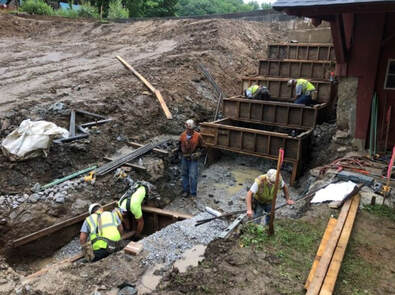 Training wall construction
Training wall construction
Concrete work was the main focus for weeks 4 and 5 of Phase I of the lower lake dam rehabilitation project.
Work continued on the training wall beginning with the installation of footing forms and the placement of reinforcing steel necessary to provide additional structural support. Concrete demolition and removal were done to the original dam parapet wall. For this project, the new walls are relatively low, constructed of reinforced concrete and tie into existing concrete sections.
Throughout this project, concrete has been sampled to determine whether it can bear the weight of what's on top of it. Reinforcing steel continues to be inspected for proper size, spacing and placement in accordance with project plans and specifications.
Two test pits (or trial pits) were excavated in order to determine how safe the area is for both personnel and equipment. Test pits are also helpful in determining how well groundwater will drain, how sturdy a soil pack is beneath an existing foundation and how much dirt should be removed before a retaining wall is necessary.
READ ENTIRE ARTICLE for WEEK 4 AND WEEK 5 plus MORE PICTURES >>>
Work continued on the training wall beginning with the installation of footing forms and the placement of reinforcing steel necessary to provide additional structural support. Concrete demolition and removal were done to the original dam parapet wall. For this project, the new walls are relatively low, constructed of reinforced concrete and tie into existing concrete sections.
Throughout this project, concrete has been sampled to determine whether it can bear the weight of what's on top of it. Reinforcing steel continues to be inspected for proper size, spacing and placement in accordance with project plans and specifications.
Two test pits (or trial pits) were excavated in order to determine how safe the area is for both personnel and equipment. Test pits are also helpful in determining how well groundwater will drain, how sturdy a soil pack is beneath an existing foundation and how much dirt should be removed before a retaining wall is necessary.
READ ENTIRE ARTICLE for WEEK 4 AND WEEK 5 plus MORE PICTURES >>>
JULY 2019
WHY DID THE SNAKE CROSS THE CREEK? TO GET TO THE OTHER 'SSSIDE' . . .
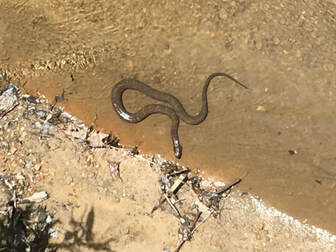
The Lake Erie watersnake is making a comeback - right here in Richfield Heritage Preserve. This little beauty was spotted in the creek below the lower lake dam.
Adult Lake Erie watersnakes, a subspecies of the Northern watersnake, come in a variety of colors, ranging from banded gray and brown blotches to solid gray with incomplete band patterns. They grow 18 to 42 inches in length and are not venomous. This snake has one of the smallest geographic ranges of any vertebrate in the world and is mainly found on the islands of Lake Erie.
This snake was originally listed as a federally threatened species in 1999 and removed from the list on August 16, 2011. Currently, all Lake Erie watersnakes remain protected under Ohio State wildlife law.
Adult Lake Erie watersnakes, a subspecies of the Northern watersnake, come in a variety of colors, ranging from banded gray and brown blotches to solid gray with incomplete band patterns. They grow 18 to 42 inches in length and are not venomous. This snake has one of the smallest geographic ranges of any vertebrate in the world and is mainly found on the islands of Lake Erie.
This snake was originally listed as a federally threatened species in 1999 and removed from the list on August 16, 2011. Currently, all Lake Erie watersnakes remain protected under Ohio State wildlife law.
FUN FACT:
Lake Erie watersnakes mate from late May through early June. Young snakes are born mid-August through September with an average litter size of 23.
How do you measure a snake? In inches. They don't have any feet!
Lake Erie watersnakes mate from late May through early June. Young snakes are born mid-August through September with an average litter size of 23.
How do you measure a snake? In inches. They don't have any feet!
LOWER LAKE DAM REHABILITATION PROJECT WEEK 3 - WEEK OF JULY 15
The week of July 15 marked the third week of construction for Phase I of the lower lake dam rehabilitation project. This week concrete demolition and removal began at the base of the training wall - a wall built to confine or guide the flow of water. In addition, topsoil stripping and grubbing to remove trees and brush continued west of the auxiliary spillway and Kirby’s Mill. A spillway is a structure that is needed under extreme conditions to provide the safe release of flood waters from the dam to a downstream area.
Rebar and corrugated metal were installed for shoring of the footing excavation steps. READ ENTIRE ARTICLE plus MORE PICTURES >>>
Rebar and corrugated metal were installed for shoring of the footing excavation steps. READ ENTIRE ARTICLE plus MORE PICTURES >>>
LOWER LAKE DAM REHABILITATION PROJECT WEEK 2 - WEEK OF JULY 8
The week of July 8 marked the second week of construction for Phase I of the lower lake dam rehabilitation project. Work included the installation of an access road and construction entrance off Center Road (Route 303). Clearing and grubbing were completed at this entrance. Next, nearly 60 tons of aggregate was placed on top of Geo Fabric, providing stability and erosion control for the new access road.
The sundial, located just west of Kirby’s Mill, was relocated away from construction activities. Once the sundial was removed, top soil stripping and stockpiling began along the existing dam slope. READ ENTIRE ARTICLE plus MORE PICTURES AND VIDEO >>>
The sundial, located just west of Kirby’s Mill, was relocated away from construction activities. Once the sundial was removed, top soil stripping and stockpiling began along the existing dam slope. READ ENTIRE ARTICLE plus MORE PICTURES AND VIDEO >>>
LOWER LAKE DAM REHABILITATION PROJECT BEGINS - WEEK OF JULY 1
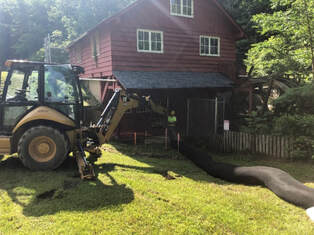 Construction fencing installed by Kirby's Mill
Construction fencing installed by Kirby's Mill
Phase I of the lower lake dam rehabilitation project began on July 1.
Work began with the installation of the construction entrance at the Oviatt Road gate located at 3771 Oviatt Road. Erosion and sediment (E&S) controls were installed to minimize erosion and to keep eroded soil on site and out of the lakes and streams running through the property. Construction fencing was erected around the project site with special attention paid to the Kirby Mill area. Clearing (removal of all vegetation) and grubbing (removal of roots that may remain in the soil) were completed. READ ENTIRE ARTICLE >>>
Work will continue through the summer with completion of the lower lake dam rehabilitation project expected sometime in September. Visitors and Buckeye Trail hikers must pay special attention to moving construction vehicles when entering/exiting the Oviatt Road entrance. Buckeye Trail hikers must follow signs to redirected trails.
Work began with the installation of the construction entrance at the Oviatt Road gate located at 3771 Oviatt Road. Erosion and sediment (E&S) controls were installed to minimize erosion and to keep eroded soil on site and out of the lakes and streams running through the property. Construction fencing was erected around the project site with special attention paid to the Kirby Mill area. Clearing (removal of all vegetation) and grubbing (removal of roots that may remain in the soil) were completed. READ ENTIRE ARTICLE >>>
Work will continue through the summer with completion of the lower lake dam rehabilitation project expected sometime in September. Visitors and Buckeye Trail hikers must pay special attention to moving construction vehicles when entering/exiting the Oviatt Road entrance. Buckeye Trail hikers must follow signs to redirected trails.
GET INVOLVED - NEW ADOPT A FENCE PROGRAM
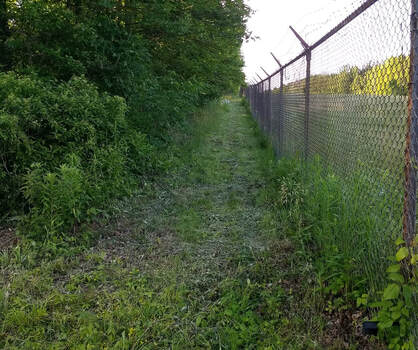 Adopt-A-Fence Program
Adopt-A-Fence Program
Calling all volunteers. The newly created Adopt-a-Fence Program may be just what you’re looking for to get involved and make a difference. The Program is designed to give you the opportunity to help us monitor and clear a section of the fence row that borders Richfield Heritage Preserve.
The term “fence row” refers to the strip of land that is on either side of the fence surrounding Richfield Heritage Preserve. In order to keep the fence in good condition, volunteers are needed to keep the four-foot wide fence row on either side of the fence clear of obstructions such as noxious weeds, brush, briers and other vegetation from spreading into the park.
Adopting a section of fence gives you the opportunity to see the park from different vantage points that few visitors take advantage of. You set your pace and you set your goal, deciding how many sections of fence in your adopted section you want to tackle each time.
If interested, contact [email protected].
The term “fence row” refers to the strip of land that is on either side of the fence surrounding Richfield Heritage Preserve. In order to keep the fence in good condition, volunteers are needed to keep the four-foot wide fence row on either side of the fence clear of obstructions such as noxious weeds, brush, briers and other vegetation from spreading into the park.
Adopting a section of fence gives you the opportunity to see the park from different vantage points that few visitors take advantage of. You set your pace and you set your goal, deciding how many sections of fence in your adopted section you want to tackle each time.
If interested, contact [email protected].
JUNE 2019
OHC "BACK IN THE SADDLE" CLINIC
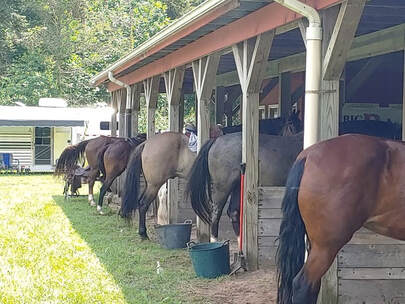 OHC 2nd Annual "Back in the Saddle Clinic"
OHC 2nd Annual "Back in the Saddle Clinic"
The Ohio Horseman’s Council (OHC), Summit County Chapter, hosted its 2nd annual “Back in the Saddle" Clinic on June 29.
Attendees participated in five clinics offered throughout the day. Wellness clinics included yoga for the equestrian and chiropractic for the rider where attendees learned that being a well-adjusted rider can help both the rider and their horse in and out of the saddle.
Other clinics demonstrated how to safely maneuver obstacles and tack/saddle repair.
The OHC-Summit County Chapter has been partnering with the park for four years. Over this time, OHC and its enthusiastic volunteers held fundraisers to raise monies used to clear and establish five miles of multi-use natural equine trails throughout the park. OHC also funded a gravel parking lot for the Summer Barn which now provides ample parking for horse trailers.
Attendees participated in five clinics offered throughout the day. Wellness clinics included yoga for the equestrian and chiropractic for the rider where attendees learned that being a well-adjusted rider can help both the rider and their horse in and out of the saddle.
Other clinics demonstrated how to safely maneuver obstacles and tack/saddle repair.
The OHC-Summit County Chapter has been partnering with the park for four years. Over this time, OHC and its enthusiastic volunteers held fundraisers to raise monies used to clear and establish five miles of multi-use natural equine trails throughout the park. OHC also funded a gravel parking lot for the Summer Barn which now provides ample parking for horse trailers.
A PATCHWORK OF LEGENDS HISTORY HIKE
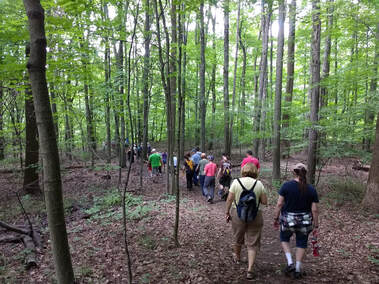
Friends of Crowell Hilaka (FoCH) hosted its second themed hike for the season, titled “A Patchwork of Legends History Hike”, on June 23. FoCH historian Lynn Richardson led close to 60 attendees through Richfield Heritage Preserve, stopping to tell stories along the way about the lesser-known tales of the park. FoCH is hosting four hikes throughout the year, each focused on a different topic -- recreation, history, education and conservation.
Attendees enjoyed learning about Hilltop House and High Lea Shelter. Hilltop House was constructed in 1949 and was the first winterized cabin built by the Cleveland Girl Scouts. It is a single room structure with a small kitchen. When in use, Campers would pull bunk beds out from the wall or spread mattresses across the floor on which to sleep.
High Lea Shelter and the Octagon Kitchen are unique in design. High Lea Shelter, located in a natural highland meadow surrounded by pine trees, is an A-frame, open-air shelter with a fire pit in the middle. It was built as a memorial to Sallie Louise Parker, a 13-year old Girl Scout who was killed by a lightning strike while she slept in her tent on August 4, 1959.
The Octagon Kitchen, directly adjacent to High Lea Shelter, was built in an octagonal (eight-sided) shape – following a belief that the radial floor plan would encourage deeper, healthier breathing. Storage units are built into one side of the octagon, a trough sink tucked into another, prep tables are built into yet two more sides, and in the center is an octagon table – all of this making it the perfect location for outdoor cooking and eating.
Missed this hike? Don’t worry. Two more hikes are scheduled for 2019. Mark your calendars for August 25 (Education – “A Dig into the Past”) and October 13 (Conservation – “Nature at Richfield Heritage Preserve”).
Attendees enjoyed learning about Hilltop House and High Lea Shelter. Hilltop House was constructed in 1949 and was the first winterized cabin built by the Cleveland Girl Scouts. It is a single room structure with a small kitchen. When in use, Campers would pull bunk beds out from the wall or spread mattresses across the floor on which to sleep.
High Lea Shelter and the Octagon Kitchen are unique in design. High Lea Shelter, located in a natural highland meadow surrounded by pine trees, is an A-frame, open-air shelter with a fire pit in the middle. It was built as a memorial to Sallie Louise Parker, a 13-year old Girl Scout who was killed by a lightning strike while she slept in her tent on August 4, 1959.
The Octagon Kitchen, directly adjacent to High Lea Shelter, was built in an octagonal (eight-sided) shape – following a belief that the radial floor plan would encourage deeper, healthier breathing. Storage units are built into one side of the octagon, a trough sink tucked into another, prep tables are built into yet two more sides, and in the center is an octagon table – all of this making it the perfect location for outdoor cooking and eating.
Missed this hike? Don’t worry. Two more hikes are scheduled for 2019. Mark your calendars for August 25 (Education – “A Dig into the Past”) and October 13 (Conservation – “Nature at Richfield Heritage Preserve”).
WE'RE BUZZING ABOUT POLLINATOR PALOOZA
The final day of Pollinators Week was held at Richfield Heritage Preserve on June 22 from 11:00 a.m. - 4:00 p.m. Representatives from the Ohio State Beekeeper chapter welcomed visitors with active honey bee hives along with answering questions about our native Ohio pollinators.
Friends of Crowell Hilaka (the Friends Group for the park) provided information on the park and led guided hikes highlighting the parks rich history and natural landscape.
Representatives from Cuyahoga Valley National Park (CVNP), Summit County Metro Parks, Ohio Department of Natural Resources (ODNR), Bureau of Ohio Natural Resources and Ohio Farm Bureau provided information on other family-oriented activities available within the area.
This free event also featured interactive displays, kids crafts, face painting and honey tasting available throughout the day.
Friends of Crowell Hilaka (the Friends Group for the park) provided information on the park and led guided hikes highlighting the parks rich history and natural landscape.
Representatives from Cuyahoga Valley National Park (CVNP), Summit County Metro Parks, Ohio Department of Natural Resources (ODNR), Bureau of Ohio Natural Resources and Ohio Farm Bureau provided information on other family-oriented activities available within the area.
This free event also featured interactive displays, kids crafts, face painting and honey tasting available throughout the day.
FUN FACT:
The queen bee can live up to five years and is the only bee that lays eggs - up to 2,500 eggs per day.
The queen bee can live up to five years and is the only bee that lays eggs - up to 2,500 eggs per day.
ONE, TWO, THREE - ANNUAL BIRD COUNT
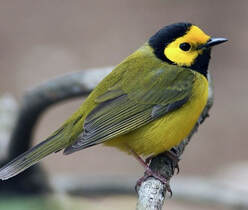 Thirteen Hooded Warblers were counted at Richfield Heritage Preserve
Thirteen Hooded Warblers were counted at Richfield Heritage Preserve
In June, members of the Greater Akron Audubon Society conducted an annual breeding bird survey at Richfield Heritage Preserve. Volunteers identified close to 50 different species over the two-day survey, covering more than four miles around the park each day.
This annual census, dating back 42 years, is a way for researchers to monitor environmental and bird population trends in our local area and determine which species are decreasing, holding steady or showing successful increases.
Visit eBird to learn what bird species have been recorded at Richfield Heritage Preserve. eBird is the most popular and scientific on-line database for birders.
This annual census, dating back 42 years, is a way for researchers to monitor environmental and bird population trends in our local area and determine which species are decreasing, holding steady or showing successful increases.
Visit eBird to learn what bird species have been recorded at Richfield Heritage Preserve. eBird is the most popular and scientific on-line database for birders.
FUN FACT:
The primary threat to birds is habitat loss. Since 1967, there has been a 70% decline in common backyard birds because of habitat fragmentation or development.
The primary threat to birds is habitat loss. Since 1967, there has been a 70% decline in common backyard birds because of habitat fragmentation or development.
DIGGING UP HISTORY IN RICHFIELD HERITAGE PRESERVE
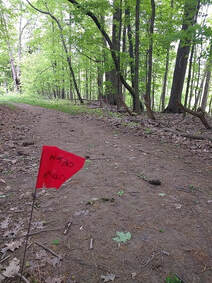 Marking and labeling dig sections
Marking and labeling dig sections
For the third consecutive year, a team of researchers from Cleveland State University (CSU) is surveying Richfield Heritage Preserve one shovelful at a time. This year the team, once again led by Dr. Phil Wanyerka, targeted 1,000 feet along the fence line on the south side of the property (W. Streetsboro Road/Route 303). In 2017, the team focused on the area around the Oviatt House and in 2018, the area surrounding the Wonken Tonken open-air shelter.
The team began by laying a grid pattern which is designed to break the area into smaller sections. These sections were marked and labeled so the location of any found artifacts could be correctly recorded. Next, shovel tests were performed as a way to cover a large area quickly. Shovel tests are minimally invasive as they do not disturb a lot of area yet provide enough data to determine how viable an area is for further archaeological testing.
Shovel by shovel, holes were dug straight into the ground. The dirt was sifted and any found artifacts were collected with their type and quantity recorded on a grid map. Areas of significant artifact clusters were identified as potential archaeological sites that needed to be further examined. From the initial 100 dig sites, the team identified an additional 50 sites of archaeological clusters.
During their three-week dig, the team uncovered fire-cracked rock which is rock of any type that has been altered and split as the result of deliberate heating. In many cases, fire-cracked rock resulted when stones were used to line hearths and earth ovens or were heated to provide a longer lasting heat source - possibly dating as far back as prehistoric times.
We thank Dr. Wanyerka and the CSU archaeological dig team for continuing to uncover the rich history hidden within Richfield Heritage Preserve.
The CSU archaeology team is working under an agreement with the park. Digging for artifacts in the park by visitors is strictly prohibited.
The team began by laying a grid pattern which is designed to break the area into smaller sections. These sections were marked and labeled so the location of any found artifacts could be correctly recorded. Next, shovel tests were performed as a way to cover a large area quickly. Shovel tests are minimally invasive as they do not disturb a lot of area yet provide enough data to determine how viable an area is for further archaeological testing.
Shovel by shovel, holes were dug straight into the ground. The dirt was sifted and any found artifacts were collected with their type and quantity recorded on a grid map. Areas of significant artifact clusters were identified as potential archaeological sites that needed to be further examined. From the initial 100 dig sites, the team identified an additional 50 sites of archaeological clusters.
During their three-week dig, the team uncovered fire-cracked rock which is rock of any type that has been altered and split as the result of deliberate heating. In many cases, fire-cracked rock resulted when stones were used to line hearths and earth ovens or were heated to provide a longer lasting heat source - possibly dating as far back as prehistoric times.
We thank Dr. Wanyerka and the CSU archaeological dig team for continuing to uncover the rich history hidden within Richfield Heritage Preserve.
The CSU archaeology team is working under an agreement with the park. Digging for artifacts in the park by visitors is strictly prohibited.
BEFORE AND AFTER - WHAT A DIFFERENCE PAINT MAKES
Thank you to all the volunteers, including members of Brunswick Boy Scout Troop 519, who took advantage of the good weather on June 8 to paint the exterior of Chagrin Cabin. Chagrin Cabin is a single room cabin with indoor and outdoor fireplaces. It also features a back porch which is protected by an overhanging roof.
Additional maintenance will be done this summer including tuck pointing the chimney and general grounds clean-up.
Additional maintenance will be done this summer including tuck pointing the chimney and general grounds clean-up.
FUN FACT:
Chagrin Cabin was built in 1964 and first used by the Girl Scouts in February, 1965. Gemini Cabin, which is a “twin sister” to Chagrin Cabin, was built in 1969.
Chagrin Cabin was built in 1964 and first used by the Girl Scouts in February, 1965. Gemini Cabin, which is a “twin sister” to Chagrin Cabin, was built in 1969.
MAY 2019
2018 - A YEAR OF DEDICATED VOLUNTEERS AND COMMUNITY INVOLVEMENT
2018 was a busy year for volunteers of Richfield Heritage Preserve. Volunteers were instrumental in undertaking numerous projects essential to preserve, maintain and improve this beautiful park by contributing their time, talents and energy.
Around the park, volunteers removed failing structures, assisted with the renovation of the new park office, cleared trails and fence lines and installed wayfinding signage to help keep visitors safe on the trails. Volunteers also maintained the park's social media presence and created a new website focused on programs and events to help keep everyone up-to-date on park activities.
Thank you to our many volunteers along with the Richfield Fire Department, park affiliates, scout and church groups, students and Richfield residents who all made a lasting impact in 2018.
Around the park, volunteers removed failing structures, assisted with the renovation of the new park office, cleared trails and fence lines and installed wayfinding signage to help keep visitors safe on the trails. Volunteers also maintained the park's social media presence and created a new website focused on programs and events to help keep everyone up-to-date on park activities.
Thank you to our many volunteers along with the Richfield Fire Department, park affiliates, scout and church groups, students and Richfield residents who all made a lasting impact in 2018.
|
|
ROW, ROW, ROW YOUR BOAT
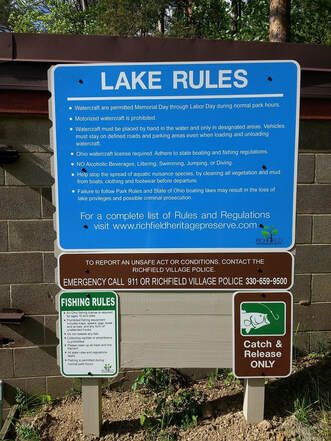 Lake Rules for Richfield Heritage Preserve
Lake Rules for Richfield Heritage Preserve
Welcome summer. Welcome boating.
Beginning Memorial Day and extending through Labor Day, non-motorized watercrafts are permitted in Lake Linnea at Richfield Heritage Preserve during normal park hours. Also known as the Upper Lake, Lake Linnea covers 8.3 acres and has three small islands. A boat house and dock sit just above the dam spillway.
Vehicles must stay on defined roads and parking areas even when loading and unloading watercraft. All watercrafts must be placed by hand when entering and exiting the lake from the boat-launching areas.
Life jackets must be worn at all times. Swimming from the watercraft and alcohol are strictly prohibited. When using the lake, State boating and fishing regulations apply. All watercraft must be licensed by the State of Ohio.
We suggest you educate yourself on the products and practices that are safe for the environment. Aquatic nuisance species such as Hydrilla can be spread from one body of water to another. Hydrilla, also commonly known as water thyme, is considered one of the worst aquatic weeds in the United States. The plant is rooted in the bed of the waterbody and has long stems (up to 25 feet in length) that branch at the surface where growth then becomes horizontal and forms dense mats.
To stop the spread of aquatic nuisance species, clean all vegetation and mud from boats, motors, trailers, clothing and footwear before leaving the area.
Failure to follow park rules and State of Ohio boating laws will result in the loss of lake privileges and possible criminal prosecution.
Complete list of Watercraft Rules and Regulations
Park Rules and Regulations
Beginning Memorial Day and extending through Labor Day, non-motorized watercrafts are permitted in Lake Linnea at Richfield Heritage Preserve during normal park hours. Also known as the Upper Lake, Lake Linnea covers 8.3 acres and has three small islands. A boat house and dock sit just above the dam spillway.
Vehicles must stay on defined roads and parking areas even when loading and unloading watercraft. All watercrafts must be placed by hand when entering and exiting the lake from the boat-launching areas.
Life jackets must be worn at all times. Swimming from the watercraft and alcohol are strictly prohibited. When using the lake, State boating and fishing regulations apply. All watercraft must be licensed by the State of Ohio.
We suggest you educate yourself on the products and practices that are safe for the environment. Aquatic nuisance species such as Hydrilla can be spread from one body of water to another. Hydrilla, also commonly known as water thyme, is considered one of the worst aquatic weeds in the United States. The plant is rooted in the bed of the waterbody and has long stems (up to 25 feet in length) that branch at the surface where growth then becomes horizontal and forms dense mats.
To stop the spread of aquatic nuisance species, clean all vegetation and mud from boats, motors, trailers, clothing and footwear before leaving the area.
Failure to follow park rules and State of Ohio boating laws will result in the loss of lake privileges and possible criminal prosecution.
Complete list of Watercraft Rules and Regulations
Park Rules and Regulations
STRONGSVILLE ROTC HELPS US RIDE THROUGH RICHFIELD HERITAGE PRESERVE
Members of the Strongsville Air Force Junior ROTC removed a portion of the Summer Barn fence in preparation for the Ohio Horseman's Council (OHC) "Back in the Saddle Clinic" on June 29. Register Here.
The Strongsville Air Force Junior ROTC instructors teach life skills to the students such as principles of flight, flight power, creating budgets, preparation for college and developing career skills. Each cadet is required to complete 12 hours of community service each school year.
Richfield Heritage Preserve is very grateful to the Strongsville Air Force Junior ROTC for their hard work and dedication.
The Strongsville Air Force Junior ROTC instructors teach life skills to the students such as principles of flight, flight power, creating budgets, preparation for college and developing career skills. Each cadet is required to complete 12 hours of community service each school year.
Richfield Heritage Preserve is very grateful to the Strongsville Air Force Junior ROTC for their hard work and dedication.
INDIAN GUIDES AND INDIAN PRINCESSES LEARN SAFETY SKILLS
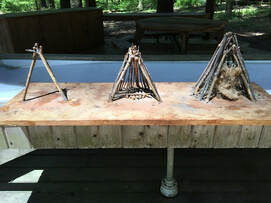 Safe fire starting
Safe fire starting
The Midwest Native Skills Institute facilitated two Nature Awareness classes for local Indian Guide and Indian Princess circles on May 11.
The group of eight- to eleven-year olds and their fathers learned how to stay safe in the woods and what to do if they did get lost. Other activities included learning about the different types of fires and how to build a fire with and without a match.
Under close supervision, each child had the opportunity to start their own fire using a charred cotton ball - which they all thoroughly enjoyed.
The group of eight- to eleven-year olds and their fathers learned how to stay safe in the woods and what to do if they did get lost. Other activities included learning about the different types of fires and how to build a fire with and without a match.
Under close supervision, each child had the opportunity to start their own fire using a charred cotton ball - which they all thoroughly enjoyed.
SCOUTS RELOCATE SAPLINGS
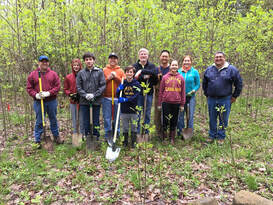 Northfield Boy Scout Troop 575
Northfield Boy Scout Troop 575
Northfield Boy Scout Troop 575 completed its conservation project at the park on May 5. They relocated twelve Tulip tree saplings from the Windy Hill site to areas around the Oviatt House and gate. A mature Tulip tree at the site had gone to seed, creating a grove of Tulip tree saplings.
RJRD board member Jeff DeLuca shared his horticultural expertise with the troop, showing them the proper way to dig up and wrap the roots in burlap to protect the saplings during transport.
The saplings were moved from the Windy Hill site in preparation for making this area usable for camping and shelter rental. Our thanks to Northfield Boy Scout Troop 575 for their hard work in giving these saplings a new home.
RJRD board member Jeff DeLuca shared his horticultural expertise with the troop, showing them the proper way to dig up and wrap the roots in burlap to protect the saplings during transport.
The saplings were moved from the Windy Hill site in preparation for making this area usable for camping and shelter rental. Our thanks to Northfield Boy Scout Troop 575 for their hard work in giving these saplings a new home.
FUN FACT:
Tulip trees are widely known for their large flowers superficially resembling tulips. The flowers are 1 – 4 inches in diameter and have nine tepals — three green outer sepals and six inner petals which are yellow-green with an orange flare at the base. These flowers begin forming after around 15 years. Tulip trees can grow 70 – 100 feet tall.
Tulip trees are widely known for their large flowers superficially resembling tulips. The flowers are 1 – 4 inches in diameter and have nine tepals — three green outer sepals and six inner petals which are yellow-green with an orange flare at the base. These flowers begin forming after around 15 years. Tulip trees can grow 70 – 100 feet tall.
DEFENDING THE FOREST CONTINUES
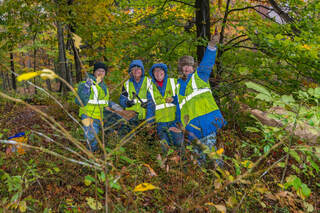 Defenders of the Forest
Defenders of the Forest
On May 4, the Friends of Crowell Hilaka held its second Garlic Mustard Pull for 2019. Volunteers removed 45 pounds of garlic mustard along with 20 barberry bushes. Garlic mustard removal is the focus April through June; Barberry removal is the focus July through November. However, when the opportunity presents itself, it all goes!
An "invasive plant" is a name for a species that is not native to a specific location and has become a weed which grows aggressively, spreads and displaces other native plants.
Watch for postings for the next invasive species removal event.
RICHFIELD FIREFIGHTERS 2019 5K TRAIL RUN AND 1-MILE WALK
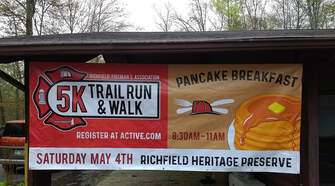
The fourth annual Richfield Firefighters 5K trail run and one-mile walk took place on Saturday, May 4 at Richfield Heritage Preserve. Despite fog and muddy trails, approximately 90 people participated. New this year was a Virtual Runner category for those who couldn't attend the event or simply don’t like to run!
Awards were presented to the top overall male and female runners and to the first, second and third place male and female runners in the different age categories. Click here for the results.
Navy veteran Michelle Wisniewski sang a beautiful rendition of the National Anthem before the start of today's race. Michelle's mission is to bring the National Anthem back to sporting events.
Chief Phil of the Richfield Fire Department presented an American flag with a re-purposed fire extinguisher base to RJRD board members Meg Slifcak and Bill Smith after today's race. The flag will be located in Gund Hall.
With the help of the Fire Explorers as well as association members, pancake and sausage breakfasts were served along with a raffle for terrific prizes. Richfield Boy Scout Troop 387 assisted with parking. Total proceeds raised from this year’s event will go towards programs and services.
Awards were presented to the top overall male and female runners and to the first, second and third place male and female runners in the different age categories. Click here for the results.
Navy veteran Michelle Wisniewski sang a beautiful rendition of the National Anthem before the start of today's race. Michelle's mission is to bring the National Anthem back to sporting events.
Chief Phil of the Richfield Fire Department presented an American flag with a re-purposed fire extinguisher base to RJRD board members Meg Slifcak and Bill Smith after today's race. The flag will be located in Gund Hall.
With the help of the Fire Explorers as well as association members, pancake and sausage breakfasts were served along with a raffle for terrific prizes. Richfield Boy Scout Troop 387 assisted with parking. Total proceeds raised from this year’s event will go towards programs and services.
What happened at Richfield Heritage Preserve in April – A LOT!! A number of projects were completed in April including chimney repairs, installation of a new roof on Kirby’s Mill, electrical repair to the Oviatt Road gate, a Cub Scout service project, installation of a parking lot at the Summer Barn, invasive species management and the start of two of the parks’ largest capital projects: renovation to the lower lake dam and improvements to the Waste Water Treatment Plant (WWTP).
APRIL 2019
PHASE I BEGINS - REHABILITATION OF LOWER LAKE DAM
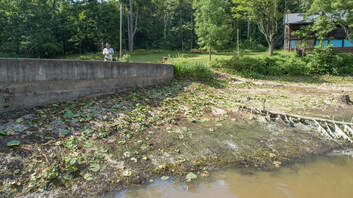 Lower Lake Dam ready for construction to begin
Lower Lake Dam ready for construction to begin
Phase I of the lower lake dam rehabilitation project is about to begin. Bid requests were posted, responses received and reviewed, and the winning bids awarded in April to Gannett Fleming Engineers and Architects, P.C. and to Black Horse Bridge Construction, Inc.
Improvements include earthwork along the dam and auxiliary spillway, installation of a reinforced concrete retaining wall, reinforced concrete slab, metal staircase and an articulating concrete block (ACB) revetment system* to provide erosion protection.
MORE >>>
Improvements include earthwork along the dam and auxiliary spillway, installation of a reinforced concrete retaining wall, reinforced concrete slab, metal staircase and an articulating concrete block (ACB) revetment system* to provide erosion protection.
MORE >>>
IMPROVEMENTS TO WASTE WATER TREATMENT PLANT
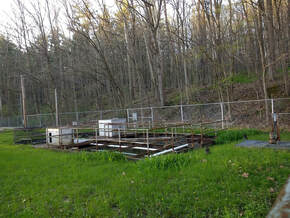 Existing WWTP
Existing WWTP
Improvements to the park’s existing Waste Water Treatment Plant (WWTP) are vital to the continued operation of the park. Bid requests were posted, responses received and reviewed, and the winning bid awarded in April to Workman Industrial Services, Inc.
Improvements to the WWTP include replacing the existing pump station and adding a power-loss alarm system which would provide a local visual alarm if utility power serving the WWTP is lost, notifying operation personnel of the condition. The new WWTP will connect the buildings to a sewer system, essential for operations of the park.
MORE >>>
Improvements to the WWTP include replacing the existing pump station and adding a power-loss alarm system which would provide a local visual alarm if utility power serving the WWTP is lost, notifying operation personnel of the condition. The new WWTP will connect the buildings to a sewer system, essential for operations of the park.
MORE >>>
CHIMNEY REPAIRS TO CHAGRIN CABIN AND KIRBY'S HOUSE
Contractors completed masonry work on the chimneys of Gemini Cabin and Kirby’s House. Tuck pointing was completed in one day on Gemini Cabin. This work is part of the efforts needed to make this a rentable facility.
The Kirby House chimney repair wasn’t as easy. After an initial inspection, it was believed only minor repairs were needed. However, once contractors began removing the loose stones, it was determined that any additional movement could cause the entire chimney to collapse. Work stopped until the necessary safety precautions were put in place. When work resumed, a base color mortar was used to adhere the stones in place and a different color mortar was used to recreate the rope mortar joint between the stones to match the existing joints. The rope mortar joint is used almost exclusively in historical restorations.
The Kirby House chimney repair wasn’t as easy. After an initial inspection, it was believed only minor repairs were needed. However, once contractors began removing the loose stones, it was determined that any additional movement could cause the entire chimney to collapse. Work stopped until the necessary safety precautions were put in place. When work resumed, a base color mortar was used to adhere the stones in place and a different color mortar was used to recreate the rope mortar joint between the stones to match the existing joints. The rope mortar joint is used almost exclusively in historical restorations.
FUN FACT:
Construction of Kirby’s house began in 1920 and ended in 1921. When you stand in front of the chimney, you can see stones in the shapes of “1, 9, 2, and 1” placed vertically in the design, commemorating the year when construction of the house was completed.
Construction of Kirby’s house began in 1920 and ended in 1921. When you stand in front of the chimney, you can see stones in the shapes of “1, 9, 2, and 1” placed vertically in the design, commemorating the year when construction of the house was completed.
WE’RE GETTING WIRED
|
Contractors are finishing the installation of electrical wiring and components needed to make the Oviatt House gate operational before the Lower Lake Dam and Waste Water Treatment Plant projects can begin. The automation of the gate will give contractors easier access to the construction site as well as make deliveries of materials faster and safer. |
OHC GEARING UP FOR ‘BACK IN THE SADDLE CLINIC’
The Ohio Horseman's Council (OHC) and its enthusiastic volunteers not only rebuilt more than four miles of horse trails within Richfield Heritage Preserve, the group most recently installed a parking lot by the Summer Barn (4225 Oviatt Road). When complete, it will be able to accommodate eight horse trailers and ten cars.
This work is being done in preparation for the OHC ‘Back in the Saddle Clinic’. The Clinic is scheduled for Saturday, June 29. Gates to the Oviatt Road entrance will open at 8:00 a.m. Trail rides depart at 9:00 a.m. All reservations to participate must be made by Friday, June 14. No registrations will be taken the day of the event. Register here.
This work is being done in preparation for the OHC ‘Back in the Saddle Clinic’. The Clinic is scheduled for Saturday, June 29. Gates to the Oviatt Road entrance will open at 8:00 a.m. Trail rides depart at 9:00 a.m. All reservations to participate must be made by Friday, June 14. No registrations will be taken the day of the event. Register here.
COMMUNITY SERVICE – PHI DELTA THETA FRATERNITY
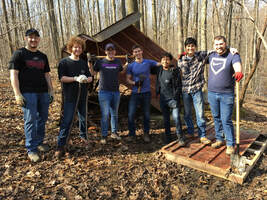 Phi Delta Theta Fraternity
Phi Delta Theta Fraternity
Members of the University of Akron's Phi Delta Theta Fraternity worked towards fulfilling their community service hours at Richfield Heritage Preserve. As their service project, the group torn down a latrine near Seely Cabin due to its state of disrepair and the close proximity to nicer facilities.
Each member of the University of Akron's Phi Delta Theta Fraternity is required to complete 12-15 hours of community service per semester. We are so THANKFUL they chose Richfield Heritage Preserve to fulfill that obligation. They were a big help!
Each member of the University of Akron's Phi Delta Theta Fraternity is required to complete 12-15 hours of community service per semester. We are so THANKFUL they chose Richfield Heritage Preserve to fulfill that obligation. They were a big help!
FUN FACT:
Seely Cabin was named for Warner and Emma Seely. Emma was the commissioner of the Cleveland Girl Scout Council from 1931 to 1933. Warner was the chairman of the fundraising campaign. He was instrumental in helping purchase the Kirby estate for the Cleveland council in 1937.
Plans are to finish converting Seely Cabin into an open-air shelter.
Seely Cabin was named for Warner and Emma Seely. Emma was the commissioner of the Cleveland Girl Scout Council from 1931 to 1933. Warner was the chairman of the fundraising campaign. He was instrumental in helping purchase the Kirby estate for the Cleveland council in 1937.
Plans are to finish converting Seely Cabin into an open-air shelter.
SCOUTS LEARN LIFE-LONG SKILLS
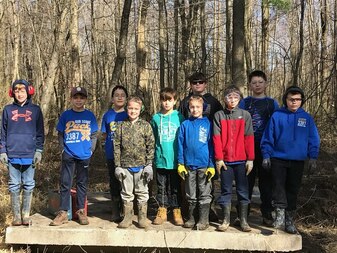 Richfield Cub Scout Den 3387
Richfield Cub Scout Den 3387
Thank you to Richfield Cub Scout Den 3387 who expressed interest in completing a “substantial” service project at Richfield Heritage Preserve. They suggested a project where the Den could learn basic carpentry skills through hands-on tasks such as installing boards and figuring the proper angle for the roof.
The Den of 12 boys, with the help of many of their dads, built a new latrine at Gemini Cabin. The original latrine was in a state of disrepair and was demolished in March of 2018.
The new Gemini latrine is modeled after the Wonken Tonken latrine, built on an existing concrete pad and crocks left by the Girl Scouts. The RJRD board purchased the materials needed and repurposed roofing shingles left over from other projects.
This is just one step closer to reaching the goal of making Gemini Cabin and the surrounding area rentable. Painting of the latrine will be done within the next few weeks as weather permits.
The Den of 12 boys, with the help of many of their dads, built a new latrine at Gemini Cabin. The original latrine was in a state of disrepair and was demolished in March of 2018.
The new Gemini latrine is modeled after the Wonken Tonken latrine, built on an existing concrete pad and crocks left by the Girl Scouts. The RJRD board purchased the materials needed and repurposed roofing shingles left over from other projects.
This is just one step closer to reaching the goal of making Gemini Cabin and the surrounding area rentable. Painting of the latrine will be done within the next few weeks as weather permits.
FUN FACT:
Gemini Cabin was built in 1969, with the help of the Cleveland Rotary Club, as a "twin sister" to Chagrin Valley Cabin.
Gemini Cabin was built in 1969, with the help of the Cleveland Rotary Club, as a "twin sister" to Chagrin Valley Cabin.
INVASIVE SPECIES
The Friends of Crowell Hilaka, the friends group for Richfield Heritage Preserve, held its third annual Garlic Mustard Pull on April 27. Volunteers, many returning from past years, showed up to dig in the mud to remove the invasive plant. Since beginning this program, nearly 1,100 pounds of Garlic Mustard have been bagged and removed, but the battle still rages. These plants impact wildlife by choking out natural habitats such as freshwater wetlands, causing loss of available food or altering habitat structure or function.
Missed the fun – don’t worry. Another Garlic Mustard Pull is scheduled for Saturday, May 4. All volunteers should meet at 9:00 a.m. at the Summer Horse Barn located at 4225 Oviatt Road.
Missed the fun – don’t worry. Another Garlic Mustard Pull is scheduled for Saturday, May 4. All volunteers should meet at 9:00 a.m. at the Summer Horse Barn located at 4225 Oviatt Road.
FUN FACT:
The roots of the Garlic Mustard Weed exude a chemical that inhibits other plants from growing, making it a threat to a wide variety of our native plants and habitats. Each plant can produce up to 5,000 seeds which can remain viable in the soil for 5+ years.
The roots of the Garlic Mustard Weed exude a chemical that inhibits other plants from growing, making it a threat to a wide variety of our native plants and habitats. Each plant can produce up to 5,000 seeds which can remain viable in the soil for 5+ years.
ALLEVIATING DRAINAGE ISSUES
We’re improving areas in the park where standing water is creating wet, swampy areas -- making it difficult for the Cushman carts to get around safely. The clay soil in these areas makes it almost impossible for the ground to dry thoroughly before the next rain storm.
As a solution for one soggy area north of the gas cut, a trench was dug, corrugated drainage pipe was added and then soil was added to hide the pipe.
We can’t stop the rain, but we can divert the water to help dry out these wet sections around the park.
As a solution for one soggy area north of the gas cut, a trench was dug, corrugated drainage pipe was added and then soil was added to hide the pipe.
We can’t stop the rain, but we can divert the water to help dry out these wet sections around the park.
KIRBY’S MILL GETS A NEW ROOF
The Friends of Crowell Hilaka (FoCH) adopted Kirby’s Mill as its restoration project within the park. Thanks to generous donations to the friends group, a new roof and custom-built storm windows were installed which will help protect the front of the house.
FoCH is about to begin its major fundraising campaign for the full restoration of Kirby’s Mill. Stay tuned for ways you can help.
FoCH is about to begin its major fundraising campaign for the full restoration of Kirby’s Mill. Stay tuned for ways you can help.
FUN FACT:
The water wheel on the Mill was built in 1922 by Mr. Pardee, a millwright who built many water wheels during his life. The wheel spokes and rims are made of cypress and the buckets (a.k.a. blades) are made of oak. The lumber and millwork originally cost $442.00. The wheel ran only during warm weather. Every fall the ball bearings were lubricated and packed to prevent moisture from entering the ball races.
The water wheel on the Mill was built in 1922 by Mr. Pardee, a millwright who built many water wheels during his life. The wheel spokes and rims are made of cypress and the buckets (a.k.a. blades) are made of oak. The lumber and millwork originally cost $442.00. The wheel ran only during warm weather. Every fall the ball bearings were lubricated and packed to prevent moisture from entering the ball races.
HIKING THE BUCKEYE TRAIL
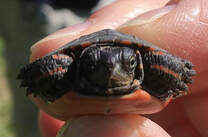 Midland Painted Turtle, one of the most common turtles in Ohio
Midland Painted Turtle, one of the most common turtles in Ohio
An organized hike, led by FoCH, took place on April 28. The event began with a pre-hike talk by Randall Roberts from the Buckeye Trail Association. Roberts is a member of the organization’s Board of Trustees and one of a handful of people who have hiked the entire Buckeye Trail. The Buckeye Trail, a 1,440+ mile hiking trail circling the state of Ohio, runs through Richfield Heritage Preserve.
Along the way, hikers heard stories about the history of the park and enjoyed a stop at Cook’s Cabin. FoCH volunteers staged the cabin to look like it would have when the Girls Scouts used it -- complete with linens on the twin beds, melamine dishes on the table and wool blankets to cuddle under.
When the Girl Scouts owned the park, the camp cook stayed in this little cabin located between Garfield Hall and the Oxbow. When the dining hall was moved to Gund Hall, Cook's Cabin was used by camp program directors as an out-of-the-way headquarters. It has also served as a dressing room for actors presenting programs at Garfield Hall.
And, look who joined the fun – a Midland Painted Turtle (MPT). If you’ve seen a turtle basking in the sun in Ohio, and wondered what kind of turtle it was, the odds are it’s an MPT, one of the most common turtles in Ohio. It is easily identified by the red markings on the side edge of its shell, its neck and its legs (up near the shell).
Missed the fun? Mark your calendars for three additional FoCH sponsored hikes scheduled for 2019:
June 23, August 25, and October 23.
Along the way, hikers heard stories about the history of the park and enjoyed a stop at Cook’s Cabin. FoCH volunteers staged the cabin to look like it would have when the Girls Scouts used it -- complete with linens on the twin beds, melamine dishes on the table and wool blankets to cuddle under.
When the Girl Scouts owned the park, the camp cook stayed in this little cabin located between Garfield Hall and the Oxbow. When the dining hall was moved to Gund Hall, Cook's Cabin was used by camp program directors as an out-of-the-way headquarters. It has also served as a dressing room for actors presenting programs at Garfield Hall.
And, look who joined the fun – a Midland Painted Turtle (MPT). If you’ve seen a turtle basking in the sun in Ohio, and wondered what kind of turtle it was, the odds are it’s an MPT, one of the most common turtles in Ohio. It is easily identified by the red markings on the side edge of its shell, its neck and its legs (up near the shell).
Missed the fun? Mark your calendars for three additional FoCH sponsored hikes scheduled for 2019:
June 23, August 25, and October 23.
FUN FACT:
The term “Oxbow” is widely used to refer to a U-shaped meander in a river or creek, often cut-off from the main river or flow of water. The term originated as a reference to the U-shaped metal pole that fits the underside and the sides of the neck of an ox or bullock.
The term “Oxbow” is widely used to refer to a U-shaped meander in a river or creek, often cut-off from the main river or flow of water. The term originated as a reference to the U-shaped metal pole that fits the underside and the sides of the neck of an ox or bullock.
Historic references and many photos used with permission from the Friends of Crowell Hilaka

